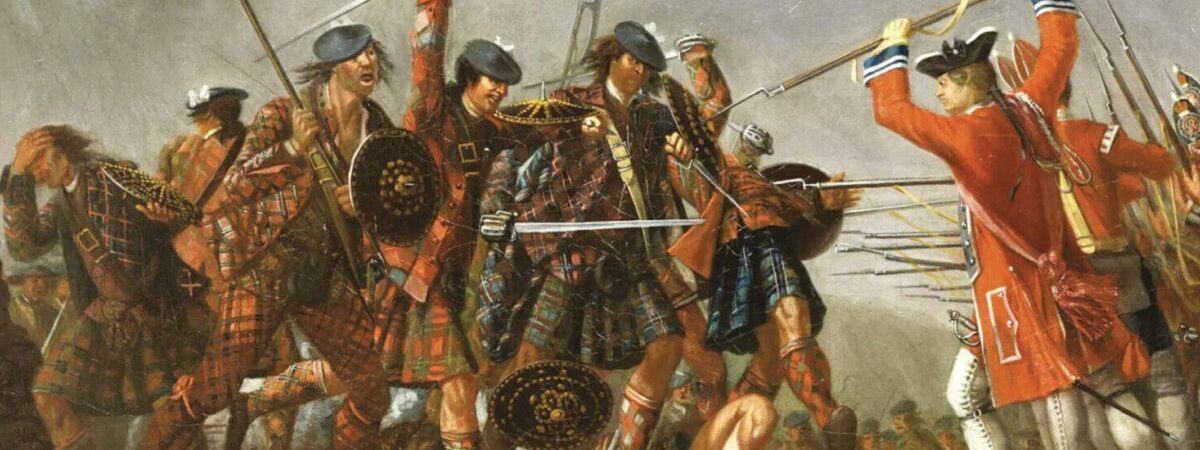
TARTAN VOL.1
Why Scots love KILT
OCTOBER – 2023 20 MINS READ
Tartan is a symbol of Scottish pride and culture, and is still loved by many people today.Tartan is a type of woolen cloth with a checkered pattern. It is traditionally associated with Scottish clans, and each clan has its own unique tartan pattern. Kilts are made from tartan, and they are a traditional Scottish garment. Tartan has a long history, dating back to the 16th century in the Highlands. Originally, tartan was a symbol of Highland clans, but it eventually became a symbol of Scotland as a whole. However, in the 18th century, Scotland came under British rule, and tartan was banned, leading to its decline. After the ban was lifted in 1782, tartan began to be seen again. During WWI, Scottish soldiers were known for their bravery, and were even called “The Ladies of the Battlefield” by the German army.
スコットランドにはチェック柄の布「タータン」があります。そして部族ごとに違う模様で編んだ布をキルトと言います。タータンは、スコットランド人の誇りです。タータンの歴史は古く、16世紀頃にハイランド地方で生まれたとされています。タータンは、当初はハイランド地方の氏族を象徴するものでしたが、やがてスコットランド全体の象徴として広く親しまれるようになりました。しかし、18世紀になると、スコットランドはイギリスの支配下に入り、タータンの着用が禁止されるなど、タータンは衰退の一途をたどります。その後、1782年禁止令が廃止されタータンは再び注目されるようになります。WW1の際にはその勇猛果敢な戦い方から、ドイツ軍から戦場では「戦場の貴婦人」とまで言われました。
The great kilt
The modern kilt has a history dating back to at least the end of the 16th century. It first appeared as the belted plaid or great kilt, a full-length garment whose upper half could be worn as a cloak draped over the shoulder, or brought up over the head as a hood. The small kilt or walking kilt (similar to the modern or military kilt) did not develop until the late 17th or early 18th century, and is essentially the bottom half of the great kilt.The word kilt comes from the Scots verb kilt, meaning “to tuck up the clothes around the body.” The Scots word derives from the Old Norse kjalta, meaning “lap” or “fold of a gathered skirt.”
The belted plaid, also known as the great plaid, is a garment that evolved from the earlier “brat” or woollen cloak in the 16th century. It was made of thick woollen cloth and was gathered up and belted. The upper half could be worn as a cloak, hung down over the belt, or brought up over the shoulders or head for protection against the weather. The belted plaid was worn over a léine (a full-sleeved tunic stopping below the waist) and could also serve as a camping blanket.
The belted plaid, also known as the great plaid, evolved from the earlier “brat” or woollen cloak in the 16th century. As wool became more available, the cloak grew so large that it began to be gathered up and belted. The belted plaid was originally a length of thick woollen cloth, about 54 to 60 inches (140 to 150 cm) wide and up to 7 yards (6.4 m) long, made up from two loom-widths sewn together. This garment was gathered up into pleats and secured by a wide belt.
Plaids with belt loops were in use by the 18th century. A surviving men’s belted plaid from 1822 has belt loops sewn inside it at each pattern repeat, such that it can be unpleated entirely into a blanket, or rapidly pleated with a hidden drawstring belt (with a second belt worn outside, to flatten the pleats).
The upper half of the belted plaid could be worn as a cloak draped over the left shoulder, hung down over the belt and gathered up at the front, or brought up over the shoulders or head for protection against the weather. It was worn over a léine (a full-sleeved tunic stopping below the waist) and could also serve as a camping blanket.
A description from 1746 states:
The garb is certainly very loose, and fits men inured to it to go through great fatigues, to make very quick marches, to bear out against the inclemency of the weather, to wade through rivers, and shelter in huts, woods, and rocks upon occasion; which men dressed in the low country garb could not possibly endure.
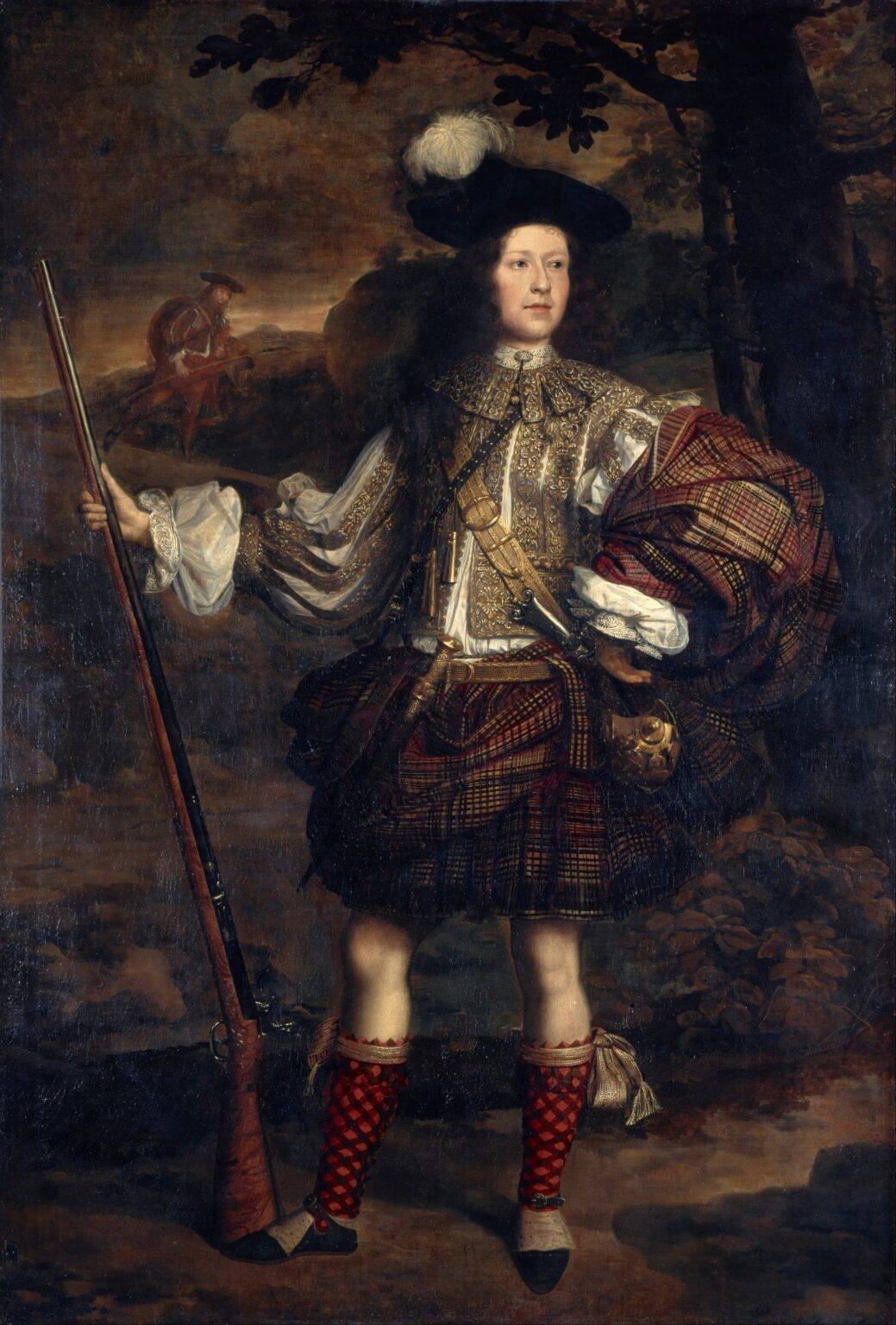
Highland chieftain Lord Mungo Murray wearing belted plaid, around 1680.
In battle, it was customary to remove the plaid beforehand and fight only in the léine croich, a knee-length shirt of leather, linen, or canvas that was heavily pleated and sometimes quilted as protection.The exact age of the great kilt is still under debate. Some carvings or illustrations from before the 16th century that appear to show the kilt may actually show the léine. The earliest written source that definitely describes the belted plaid or great kilt comes from 1594. The great kilt is mostly associated with the Scottish Highlands, but was also used in poor Lowlands rural areas. Widespread use of this type of kilt continued into the 19th century, and some still wear it today for highly formal occasions, such as white-tie evening wear, typically paired with a Sheriffmuir doublet and a ruffled jabot.
キルトは16世紀の終わり頃にはすでに存在していたと考えられており、最初はベルテッド・プレイドまたはグレート・キルトと呼ばれる、上半分を肩に羽織るマントのように着たり、頭からかぶってフードのように使うことができる、フルレングスの衣服として登場しました。スモール・キルトまたはウォーキング・キルト(現代のミリタリー・キルトに類似)は、17世紀後半から18世紀初頭にかけて開発されるまで登場せず、基本的にグレート・キルトの下半身部分にあたります。
キルトという言葉は、スコットランド語で「衣服を体に巻きつける」という意味の動詞「キルト」に由来します。スコットランド語のキルトは、古ノルド語のkjalta(「膝」または「ギャザーの入ったスカートのひだ」を意味する)から派生したものです。
ベルテッド・プレイド、別名グレート・プレイドは、16世紀の初期の「ブラット」または羊毛のマントから進化した衣服です。厚い羊毛の布で作られ、ギャザーを寄せてベルトで留めていました。上半身はマントのように着たり、ベルトから下げたり、肩や頭からかぶって寒さから身を守ったりすることができました。ベルテッド・プレイドは、レーヌ(腰より下に止まるフルスリーブのチュニック)の上に着用され、キャンプ用の毛布としても使用できました。
ベルテッド・プレイドは、18世紀にはベルトループ付きのものが使用されるようになりました。1822年の男性用ベルテッド・プレイドには、柄が繰り返されるごとに内側にベルトループが縫い付けられており、完全に毛布に広げたり、隠れたドローストリングベルト(しわを平らにするために外側に2本目のベルトを着用)で素早くプリーツを寄せることができます。ベルテッド・プレイドの上半身は、左肩に羽織るマントのように着たり、ベルトから下げて前身頃をギャザーにしたり、肩や頭からかぶって寒さから身を守ったりすることができました。レーヌ(腰より下に止まるフルスリーブのチュニック)の上に着用され、キャンプ用の毛布としても使用できました。
1746年の記述によると:スコットランドの衣装は非常にゆったりとしており、それに慣れた男性は、非常に大きな疲労を伴う行進や、悪天候に耐え、川を渉り、必要に応じて小屋や森や岩に身を寄せることができます。ローランドの服装を着た男性には、これらに耐えることは不可能です。
戦闘では、事前にプレイドを外し、膝丈の革製、リネン製、またはキャンバス製のシャツであるレーヌ・クロワだけで戦うのが通例でした。レーヌ・クロワは、保護のために大きくプリーツ加工され、時にはキルト加工もされていました。グレート・キルトの正確な起源は、まだ議論の的となっています。16世紀より前に作られたキルトを描いているように見える彫刻やイラストの中には、実際にはレーヌを描いているものもあるかもしれません。ベルテッド・プレイドまたはグレート・キルトを明確に説明している最も古い文献は、1594年のものです。グレート・キルトは主にスコットランド高地と関連していますが、貧しいローランドの農村地域でも使用されていました。このタイプのキルトは19世紀まで広く使用されており、今日でも白ネクタイのイブニングウェアなどの非常にフォーマルな場面で着用されることがあり、通常はシェリフムア・ダブレットやフリルのあるジャボットと組み合わせられます。
The small kilt or walking kilt
The kilt, as we know it today, is a relatively recent invention. It evolved from the great kilt, a belted plaid that was worn by Highlanders in the 17th and 18th centuries. The small kilt, or fèileadh beag, was first worn in the late 17th or early 18th century. It was made from a single width of cloth and worn hanging down below the belt. The small kilt quickly became popular throughout the Highlands and northern Lowlands, and by 1746, it had largely replaced the great kilt.The tailored kilt was adopted by the Highland regiments of the British Army in the early 19th century. The military kilt and its formalised accessories soon passed into civilian usage, and they have remained popular ever since.
現代のキルトは、比較的最近の発明です。17世紀から18世紀にかけてハイランダーが着用していたベルテッド・プレイドであるグレート・キルトから進化しました。スモール・キルト、またはフェイリー・ベアグは、17世紀後半から18世紀初頭にかけて最初に着用されました。これは、一枚の布から作られ、ベルトの下に垂れ下がって着用されました。スモール・キルトはハイランド地方全域と北ローランド地方で急速に普及し、1746年までにグレート・キルトに取って代わりました。テーラード・キルトは、19世紀初頭にイギリス軍のハイランド連隊によって採用されました。軍用キルトとそのフォーマルなアクセサリーはすぐに民間でも使用されるようになり、以来ずっと人気があります。
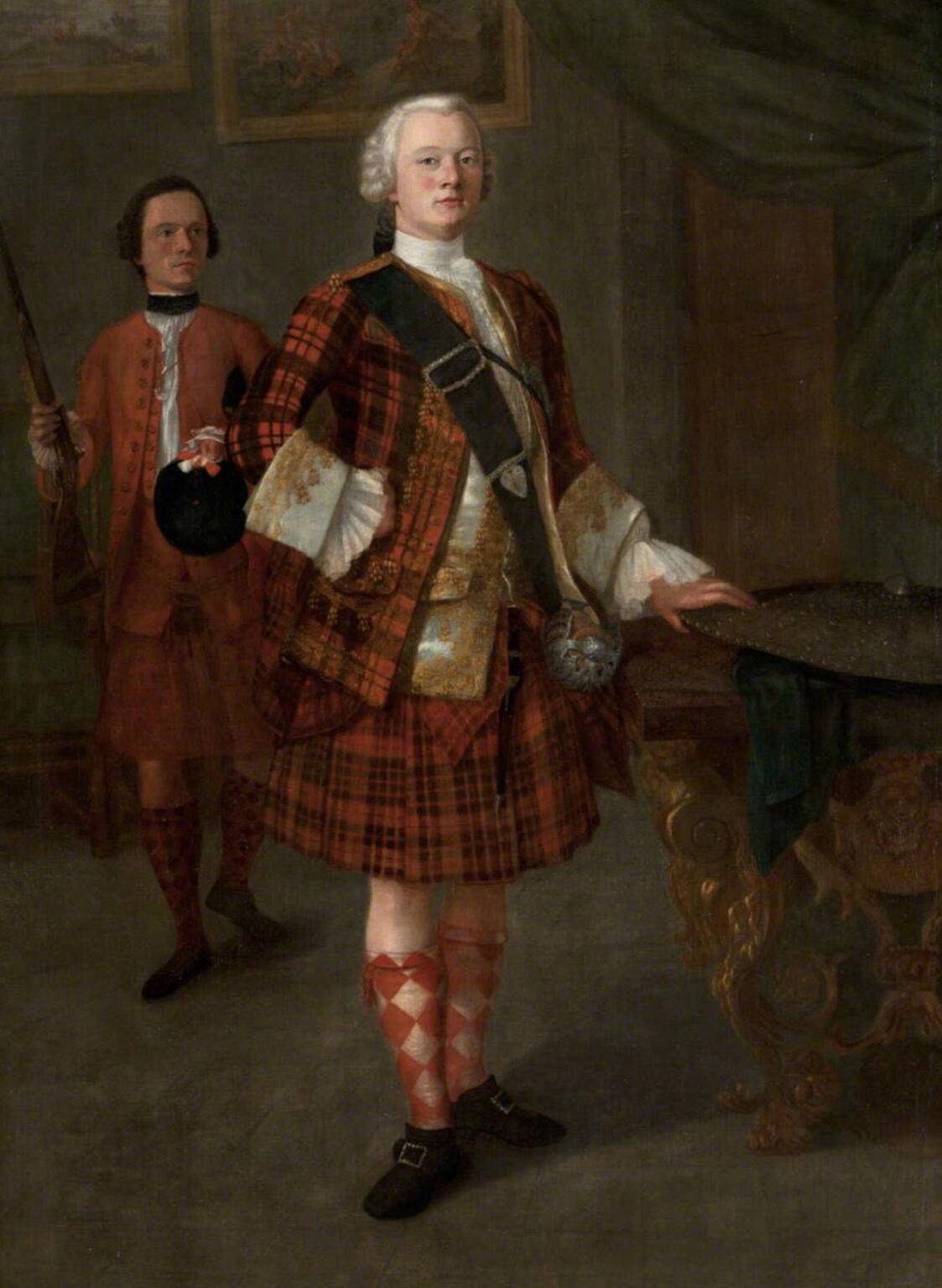
Alastair Ruadh MacDonnell, c. 1747, in a belted plaid with a retainer in the small kilt, probably the first to appear in a portrait.
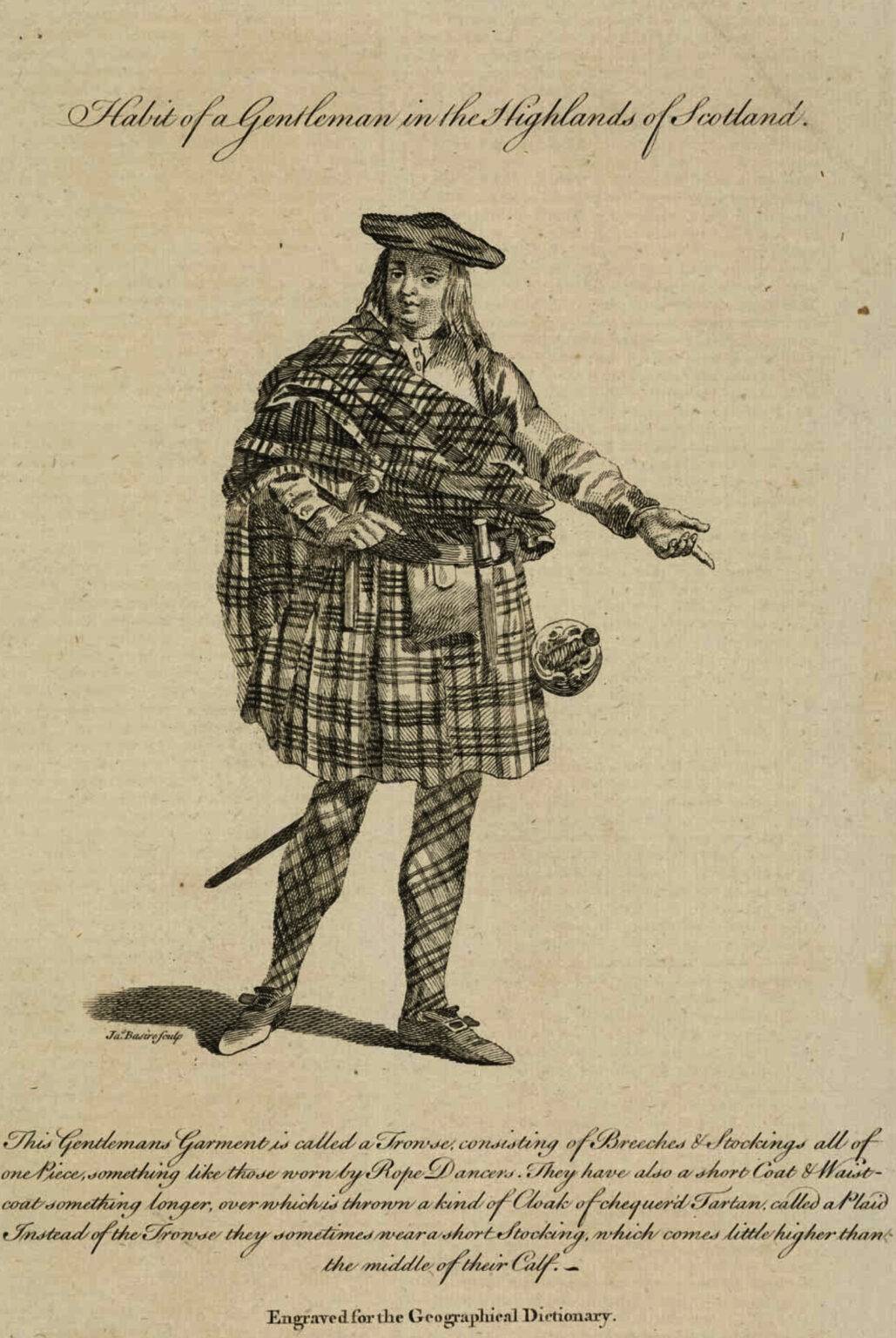
Habit of Gentleman in the Highlands of Scotland, James Basire, 1759, Work on paper, 27.1 cm X 18.9 cm, National Galleries Scotland, Edinburgh, Scotland, PGE 48.
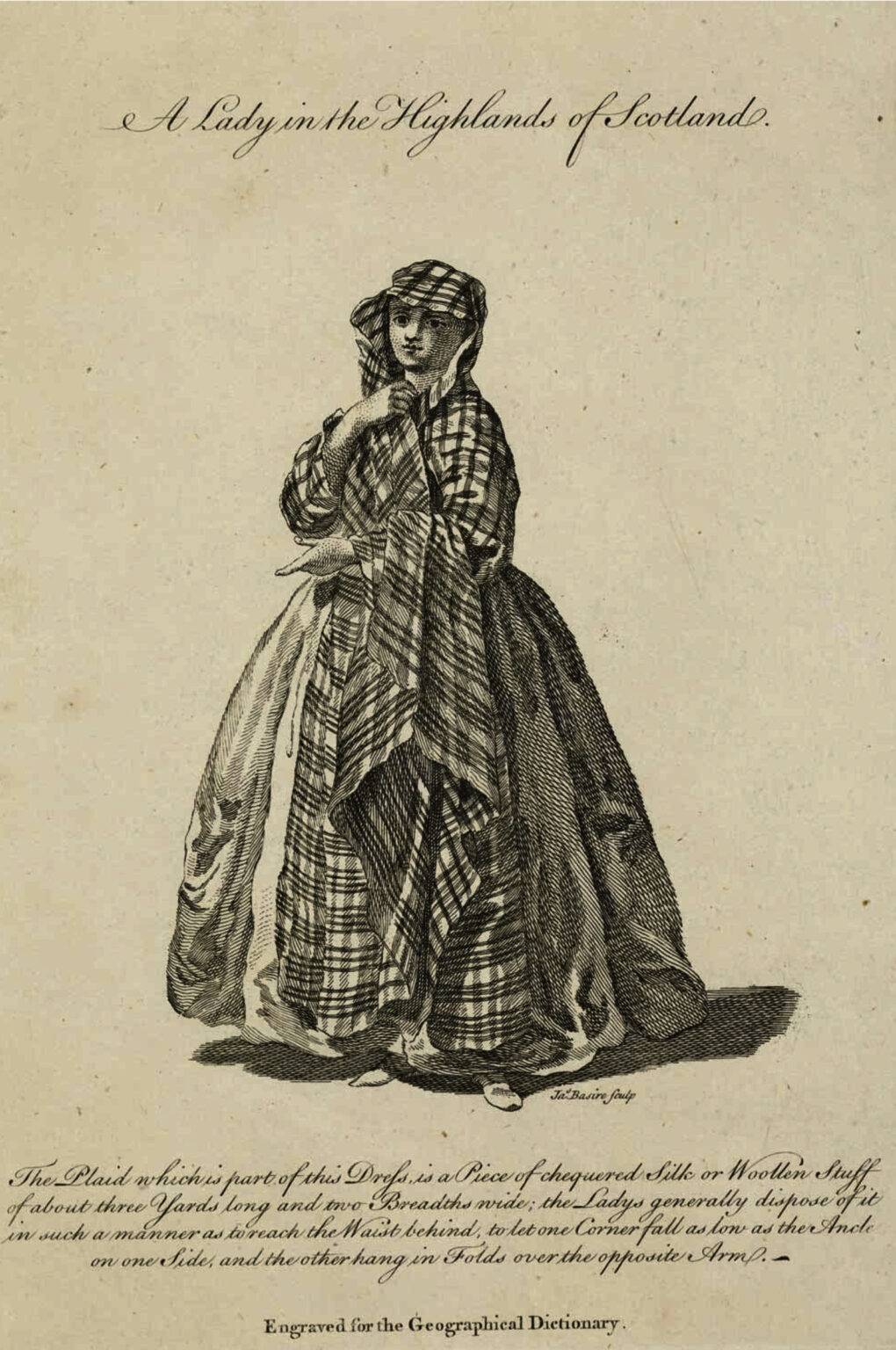
A Lady in the Highlands of Scotland, James Basire, 1759, Work on paper, 27.1 cm X 18.9 cm, National Galleries Scotland, Edinburgh, Scotland, PGE 49.

In 1765, Sir Joshua Reynolds painted John Murray, 4th Earl of Dunmore, in traditional Highlander dress, even though wearing such clothing was banned by the Act of Proscription in 1747.
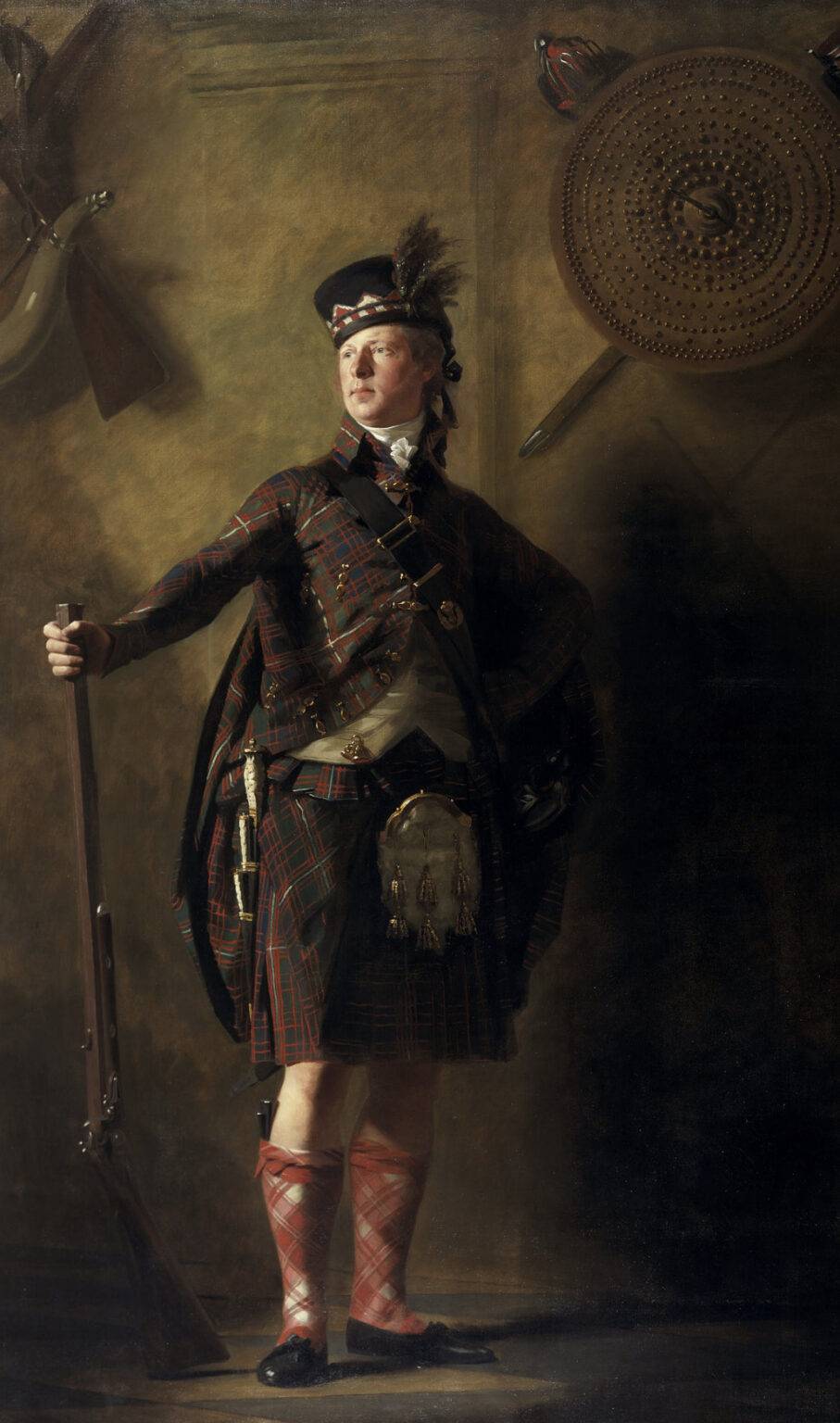
Portrait by Henry Raeburn of Alexander Ranaldson MacDonell of Glengarry in 1812.

David Wilkie’s 1829 flattering portrait of the kilted King George IV, with lighting chosen to tone down the brightness of his kilt and his knees shown bare, without the pink tights he actually wore at the event in 1822.
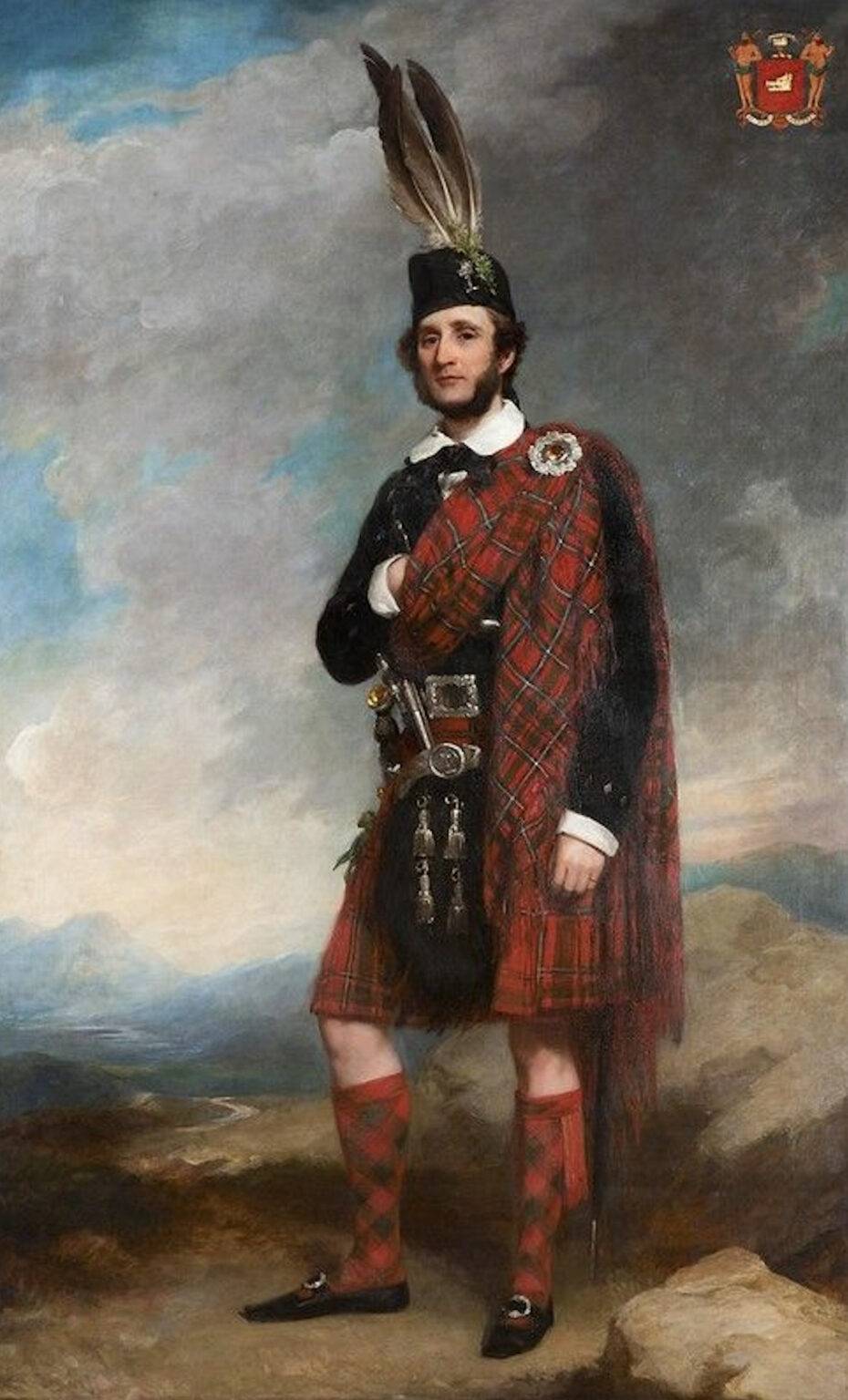
grant, sir francis – Portrait of Duncan MacDonell
; 新しいタブで開く
Sir Francis Grant 1803-1878 Schotland
invention
In 1768, Ivan Baillie wrote a letter stating that Thomas Rawlinson, an English Quaker industrialist, invented the kilt in the 1720s. Rawlinson was working with Ian MacDonnell, chief of the MacDonnells of Glengarry, to produce charcoal from the forests near Inverness and smelt iron ore there. The belted plaid worn by the Highlanders he employed was too cumbersome for this work, so Rawlinson produced a kilt which consisted of the lower half of the belted plaid worn as a “distinct garment with pleats already sewn”. He wore it himself, as did his business partner, whose clansmen then followed suit.
This story has been repeated by many writers over the years, but it has also been disputed by others. There is no evidence to support the story in Rawlinson’s own papers, and some historians believe that it was invented to discredit the kilt as a national garb.
However, it is clear that kilts were being worn in Scotland before the 1720s. There is evidence of Highlanders wearing only the bottom part of the belted plaid as early as the 1690s. And the earliest known portrait of a man wearing a small kilt dates to around 1747.
So, while it is possible that Thomas Rawlinson played a role in popularizing the kilt, it is clear that he did not invent it.
The reactions of 20th- and 21st-century researchers to the Rawlinson story have been mixed. Some, such as J. G. Mackay (1924) and Sir Thomas Innes of Learney (1939/1971), have called it a “myth” or a “wretched story.” Others, such as Dunbar (1979) and Trevor-Roper (1983), have accepted it at face value. Still others, such as Banks & de La Chapelle (2007) and Pittock (2010), have expressed skepticism, suggesting that the story is either a legend or that the workers themselves may have invented the short kilt.Purser (2020) reports that there is no evidence to support the story in Rawlinson’s own copious detailed papers. This suggests that the story may have been invented to discredit the kilt as a national garb, as Mackay (1924) suspected.In conclusion, the Rawlinson story is a controversial one that has been debated by researchers for many years. There is no clear consensus on whether or not it is true.
This story has been repeated by many writers over the years, but it has also been disputed by others. There is no evidence to support the story in Rawlinson’s own papers, and some historians believe that it was invented to discredit the kilt as a national garb.
However, it is clear that kilts were being worn in Scotland before the 1720s. There is evidence of Highlanders wearing only the bottom part of the belted plaid as early as the 1690s. And the earliest known portrait of a man wearing a small kilt dates to around 1747.
So, while it is possible that Thomas Rawlinson played a role in popularizing the kilt, it is clear that he did not invent it.
Matthew Newsome suggests in his 2000 paper that Highlanders wore the bottom part of the belted plaid as early as the 1690s. The belted plaid was a long piece of tartan cloth that was folded and belted around the body. The bottom part of the belted plaid was called the kilt.There is some debate among scholars about whether or not Highlanders wore the kilt before the 1720s. Some scholars, such as Innes of Learney and D. W. Stewart, have argued that there is evidence of 17th-century use of the kilt. Others, such as Dunbar, have disputed these claims.There is also some evidence from contemporary sources, such as Scottish coats of arms and Scots Jacobite songs, which suggests that the kilt may have been in use before the 1720s. However, none of this evidence is conclusive. It is possible that the kilt evolved over time, with different people making changes to the traditional belted plaid. It is also possible that multiple people had the idea of making the belted plaid shorter at the same time.Thomas Rawlinson is often credited with popularizing the kilt in the 1720s. Rawlinson was an English industrialist who worked with the Highland clan MacDonnell of Glengarry to produce charcoal and smelt iron ore. The belted plaid worn by the Highlanders Rawlinson employed was too cumbersome for this work, so Rawlinson had a kilt made for them. The kilt was made from the lower part of the belted plaid and had sewn-in pleats.The earliest known portrait of a man wearing a small kilt is from 1747. The portrait depicts Alastair Ruadh MacDonnell of Glengarry and a retainer.This story has been repeated by many writers over the years, but it has also been disputed by others. There is no evidence to support the story in Rawlinson’s own papers, and some historians believe that it was invented to discredit the kilt as a national garb.However, it is clear that kilts were being worn in Scotland before the 1720s. There is evidence of Highlanders wearing only the bottom part of the belted plaid as early as the 1690s. And the earliest known portrait of a man wearing a small kilt dates to around 1747.So, while it is possible that Thomas Rawlinson played a role in popularizing the kilt, it is clear that he did not invent it.
1768年、イワン・ベイリーは、英国人のクエーカー教徒である産業家トーマス・ロリンソンが1720年代にキルトを発明したと述べる手紙を書きました。ロリンソンは、インヴァネス近くの森から木炭を生産し、そこで鉄鉱石を製錬するために、マクドネル・オブ・グレンガリーの首長であるイアン・マクドネルと協力していました。彼が雇ったハイランダーが着用していたベルテッド・プレイドはこの作業にはあまりにも不便だったため、ロリンソンは「プリーツが縫い付けられた独立した衣服」として着用されるベルテッド・プレイドの下半身部で構成されるキルトを作りました。彼自身も着用し、彼のビジネスパートナーも着用しましたが、その氏族の男たちもそれに続きました。この話は長年にわたって多くの作家によって繰り返されてきましたが、他の人々によって争われてもきました。ロリンソンの私的な書類にはこの話を支持する証拠はなく、一部の歴史家はキルトを民族衣装として信用を失墜させるために作り上げられた話だと考えています。しかし、キルトは1720年代よりも前にスコットランドで着用されていたことは明らかです。1690年代初頭までに、ハイランダーたちがベルテッド・プレイドの下半身部分だけを着用していたという証拠があります。そして、スモール・キルトを着用した男性の最古の肖像画は1747年頃のものとされています。したがって、トーマス・ロリンソンがキルトの普及に役割を果たした可能性はありますが、彼がキルトを発明したことは明らかではありません。
20世紀と21世紀の研究者によるロリンソン物語に対する反応は、さまざまです。J.G.マッケイ(1924年)やサー・トーマス・インネス・オブ・ラーニー(1939年/1971年)などの研究者は、この物語を「神話」や「嘆かわしい話」と呼んでいます。一方、ダンバー(1979年)やトレバー=ロパー(1983年)などの研究者は、この物語を額面通り受け入れています。また、バンクス&ド・ラ・シャペル(2007年)やピトック(2010年)などの研究者は、この物語は伝説であるか、労働者自身がショート・キルトを発明した可能性があるとして、懐疑的な見方を示しています。パーサー(2020年)は、ロリンソン自身の膨大な詳細な書類にはこの物語を支持する証拠がないと報告しています。これは、マッケイ(1924年)が疑ったように、キルトを民族衣装として信用を失墜させるためにこの物語が作り上げられた可能性を示唆しています。結論として、ロリンソン物語は研究者によって長年議論されてきた論争の的なものです。この物語が真実かどうかについては、明確なコンセンサスはありません。
マシュー・ニューサムは2000年の論文で、ハイランダーたちは1690年代初頭からベルテッド・プレイドの下半身部を着用していたことを示唆しています。 ベルテッド・プレイドは、折り畳んで体に巻き付けてベルトで留める、タータン柄の長い布地のことです。ベルテッド・プレイドの下半身部はキルトと呼ばれていました。学者たちの間では、1720年代より前にハイランダーたちがキルトを着用していたかどうかについて議論があります。インネス・オブ・ラーニーやD.W.スチュワートなどの学者たちは、17世紀にキルトが使用されていたことを示す証拠があると主張しています。一方、ダンバーなどの学者たちは、これらの主張に異議を唱えています。また、スコットランドの紋章やスコットランドのジャコバイトの歌などの同時代の資料から、1720年代より前にキルトが使用されていた可能性を示唆する証拠もあります。しかし、これらの証拠のいずれも決定的なものではありません。キルトは時間の経過とともに進化し、さまざまな人々が伝統的なベルテッド・プレイドに変更を加えた可能性もあります。また、複数の人が同時にベルテッド・プレイドを短くするというアイデアを持った可能性もあります。トーマス・ロリンソンは、1720年代にキルトの普及に貢献した人物としてよく知られています。ロリンソンは、ハイランド氏族のマクドネル・オブ・グレンガリーと協力して、木炭の生産と鉄鉱石の製錬を行っていた英国の産業家です。ロリンソンが雇ったハイランダーたちが着用していたベルテッド・プレイドは、この作業にはあまりにも不便だったため、ロリンソンは彼らのためにキルトを作りました。キルトは、ベルテッド・プレイドの下半身部で作られ、プリーツが縫い付けられていました。
スモール・キルトを着用した男性の最古の肖像画は1747年のものです。この肖像画には、アラスター・ルアード・マクドネル・オブ・グレンガリーとその家臣が描かれています。この話は長年にわたって多くの作家によって繰り返されてきましたが、他の人々によって争われてもきました。ロリンソンの私的な書類にはこの話を支持する証拠はなく、一部の歴史家はキルトを民族衣装として信用を失墜させるために作り上げられた話だと考えています。しかし、キルトは1720年代よりも前にスコットランドで着用されていたことは明らかです。1690年代初頭までに、ハイランダーたちがベルテッド・プレイドの下半身部分だけを着用していたという証拠があります。そして、スモール・キルトを着用した男性の最古の肖像画は1747年頃のものとされています。したがって、トーマス・ロリンソンがキルトの普及に役割を果たした可能性はありますが、彼がキルトを発明したことは明らかです。
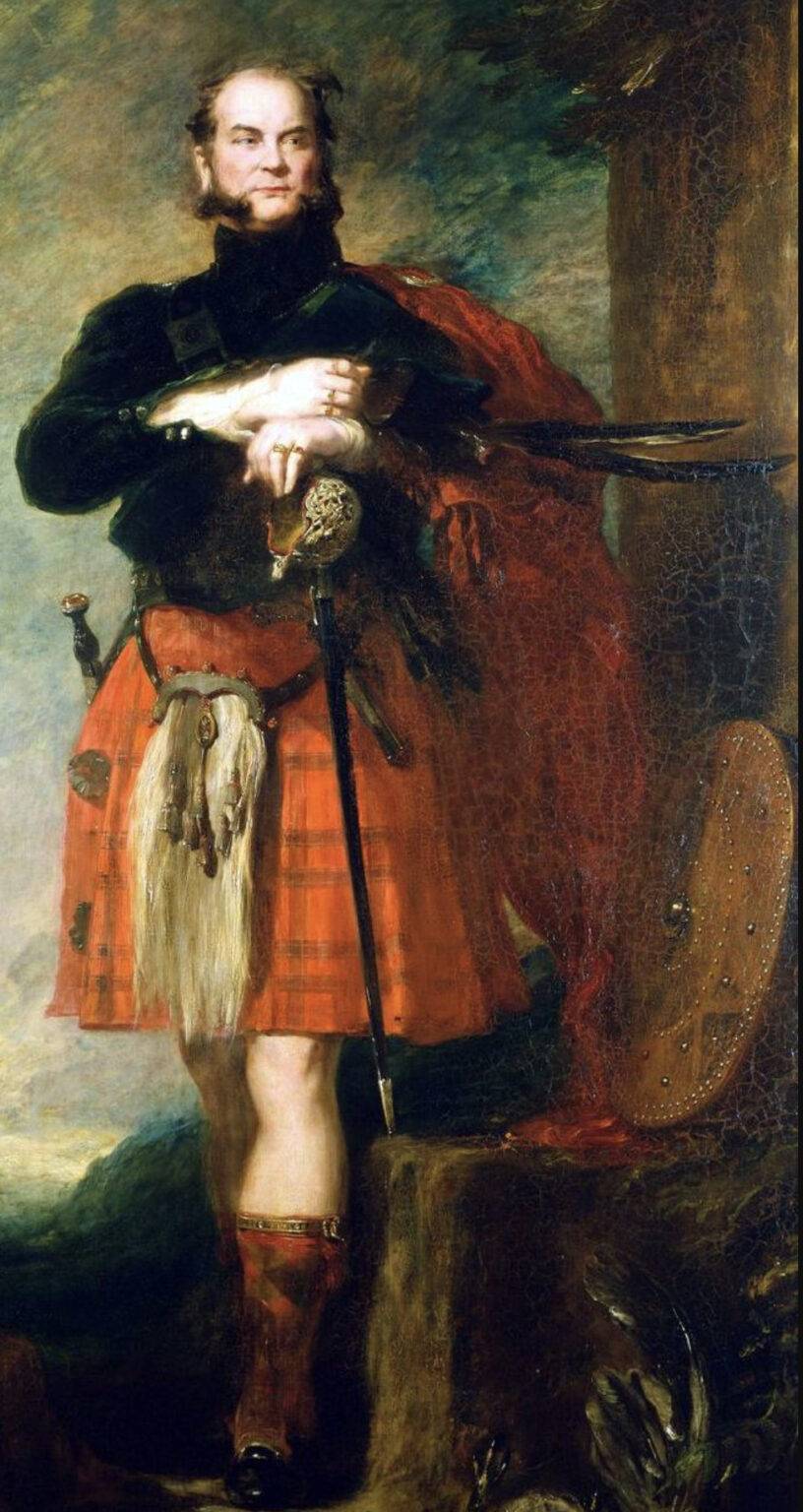
Augustus, Duke of Sussex by Sir David Wilkie 1833 wearing a kilt in the Earl of Inverness tartan, one of his subsiduary titles.
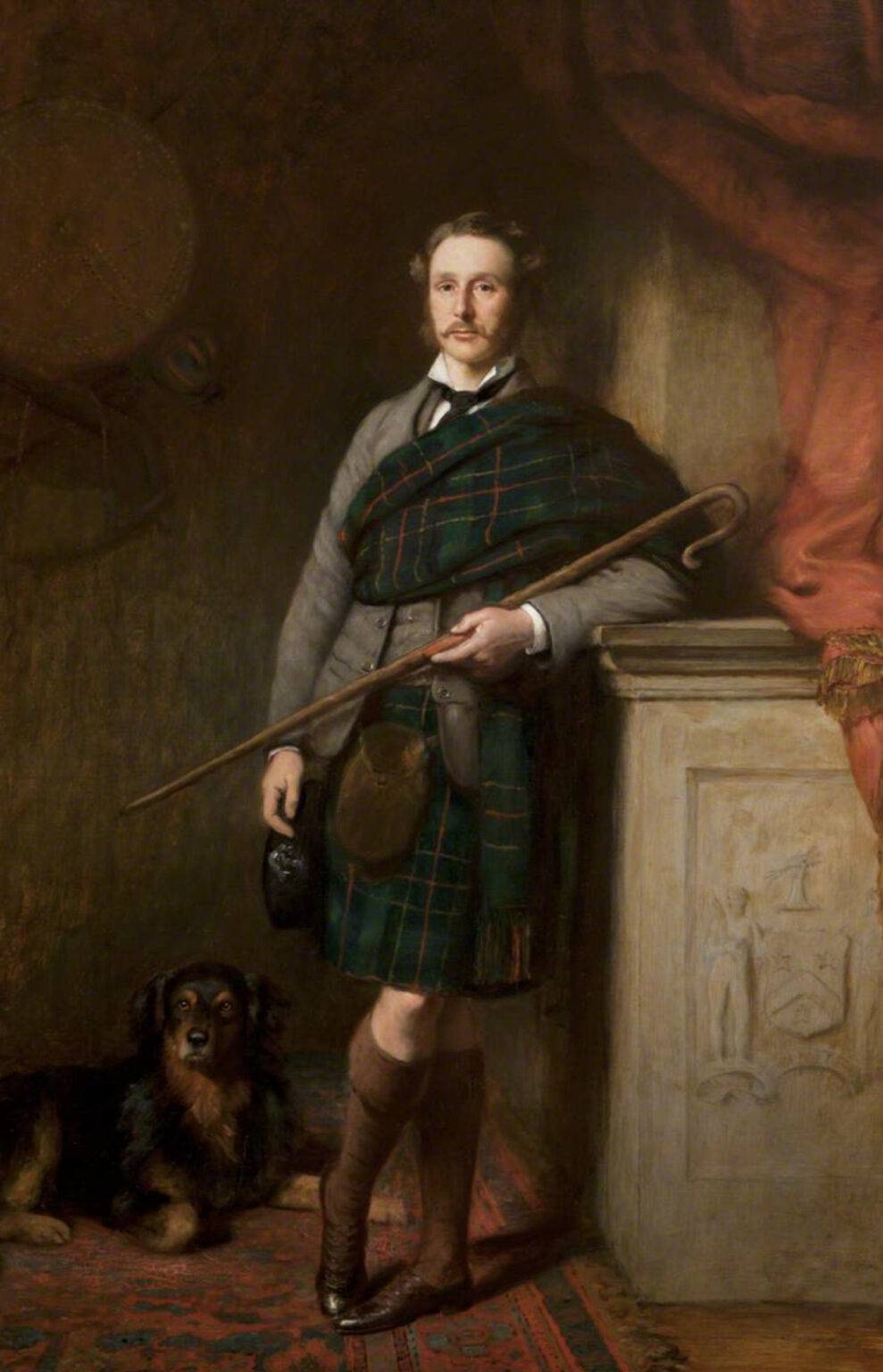
Hugh Brodie, 23rd Laird
John MacLaren Barclay (1811–1886)
Jacobite rising of 1745
In 1745, Charles Edward Stuart, the “Bonnie Prince Charlie”, launched a rebellion to regain the British throne for his father. Charles landed in Scotland with a small force and quickly gained support from Highland clans. He captured Edinburgh and won a victory at the Battle of Prestonpans.
Charles then led his army into England, hoping to rally support from English Jacobites and French forces. However, he failed to gain widespread support in England, and the French failed to land a force in the south.With government armies closing in, Charles was forced to retreat to Scotland. He suffered a decisive defeat at the Battle of Culloden in April 1746, and the rebellion was crushed. Charles escaped to France, where he lived out the rest of his life.This story has been repeated by many writers over the years, but it has also been disputed by others. There is no evidence to support the story in Rawlinson’s own papers, and some historians believe that it was invented to discredit the kilt as a national garb.However, it is clear that kilts were being worn in Scotland before the 1720s. There is evidence of Highlanders wearing only the bottom part of the belted plaid as early as the 1690s. And the earliest known portrait of a man wearing a small kilt dates to around 1747.So, while it is possible that Thomas Rawlinson played a role in popularizing the kilt, it is clear that he did not invent it.
The Jacobite Rising of 1745 had a significant impact on British history. It led to the end of the Stuart dynasty and the consolidation of British rule over Scotland. The rising also had a profound impact on Scottish culture and identity.
The British government responded to the rising with a series of repressive measures, including the Disarming Act of 1746 and the abolition of the Scottish clan system. These measures helped to suppress Jacobitism in Scotland, but they also led to a sense of bitterness and resentment among many Highlanders.The Jacobite rising also had a significant impact on Scottish culture and identity. The romantic image of the “Bonnie Prince Charlie” and the Jacobite cause has been celebrated in Scottish poetry, music, and art for centuries. The rising also helped to create a sense of shared identity among Scots, regardless of their clan or religious affiliation.This story has been repeated by many writers over the years, but it has also been disputed by others. There is no evidence to support the story in Rawlinson’s own papers, and some historians believe that it was invented to discredit the kilt as a national garb.However, it is clear that kilts were being worn in Scotland before the 1720s. There is evidence of Highlanders wearing only the bottom part of the belted plaid as early as the 1690s. And the earliest known portrait of a man wearing a small kilt dates to around 1747.So, while it is possible that Thomas Rawlinson played a role in popularizing the kilt, it is clear that he did not invent it.
1745年、チャールズ・エドワード・ステュアート(「美しきチャールズ王子」)は、父のためにイギリス王位を奪還するための反乱を起こしました。チャールズは少数の軍隊を率いてスコットランドに上陸し、すぐにハイランドの氏族の支持を得ました。彼はエディンバラを占領し、プレストンパンズの戦いで勝利を収めました。チャールズはその後、イングランドのジャコバイトとフランス軍の支持を得ることを期待して、イングランドに軍隊を率いて侵攻しました。しかし、彼はイングランドで広範な支持を得ることができず、フランスは南部に軍隊を上陸させることができませんでした。政府軍が迫る中、チャールズはスコットランドに撤退せざるを得なくなりました。彼は1746年4月のカллоденの戦いで決定的な敗北を喫し、反乱は鎮圧されました。チャールズはフランスに逃亡し、そこで残りの人生を過ごしました。この話は、長年にわたって多くの作家によって繰り返されてきましたが、他の人々によって争われてもきました。ローリンソンの自筆の論文にはこの話を支持する証拠はなく、一部の歴史家は、キルトを民族衣装として信用を失墜させるために捏造されたものであると信じています。しかし、キルトが1720年代以前にスコットランドで着用されていたことは明らかです。ハイランダーがベルト付きプレイドの下部のみを着用していた証拠は、1690年代初頭までさかのぼります。そして、小さなキルトを身に着けている男性の最古の既知の肖像画は、1747年頃の日付付けです。したがって、トーマス・ローリンソンがキルトの普及に役割を果たした可能性はありますが、彼がそれを発明したことは明らかです。1745年のジャコバイト蜂起は、イギリスの歴史に大きな影響を与えました。それは、スチュアート朝の終わりとスコットランドに対するイギリス支配の確立につながりました。蜂起はまた、スコットランドの文化とアイデンティティに大きな影響を与えました。イギリス政府は、1746年の武装解除法やスコットランド氏族制度の廃止を含む一連の抑圧的な措置で蜂起に対応しました。これらの措置は、スコットランドのジャコビズムを抑圧するのに役立ちましたが、多くのハイランダーの間で苦々しさと恨みの感情につながりました。ジャコバイト蜂起はまた、スコットランドの文化とアイデンティティに大きな影響を与えました。「美しきチャールズ王子」とジャコバイトの事業のロマンチックなイメージは、何世紀にもわたってスコットランドの詩、音楽、芸術の中で称賛されてきました。蜂起はまた、スコットランド人の氏族や宗教的信条に関係なく、スコットランド人としての共通のアイデンティティを作り出すのに役立ちました。

The Earl of Mar raising the Pretender’s standard AD 1715
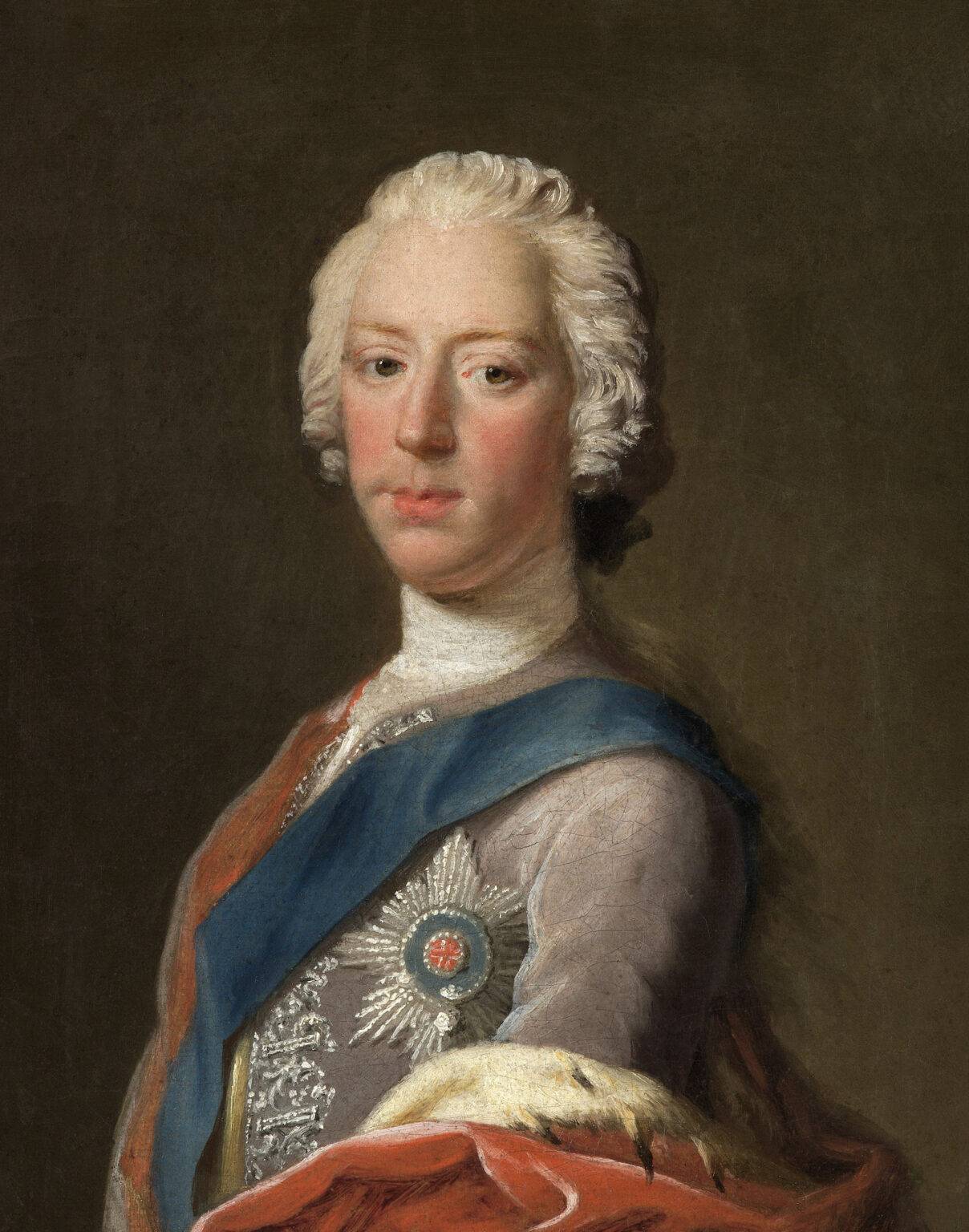
Charles Edward Stuart as European royalty, painted at Holyrood, late 1745
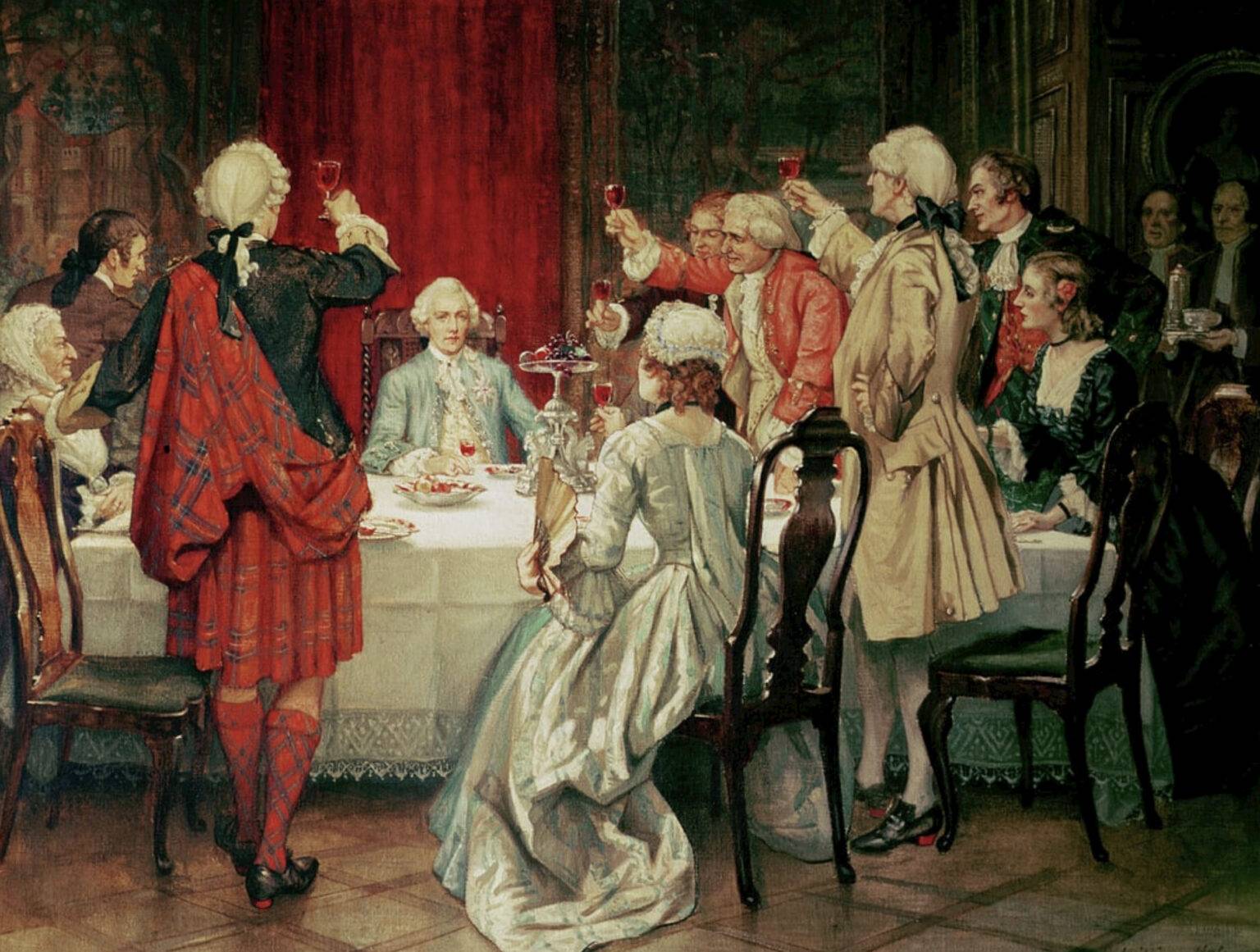
Prince Charles Edward Stuart in Edinburgh, 1745

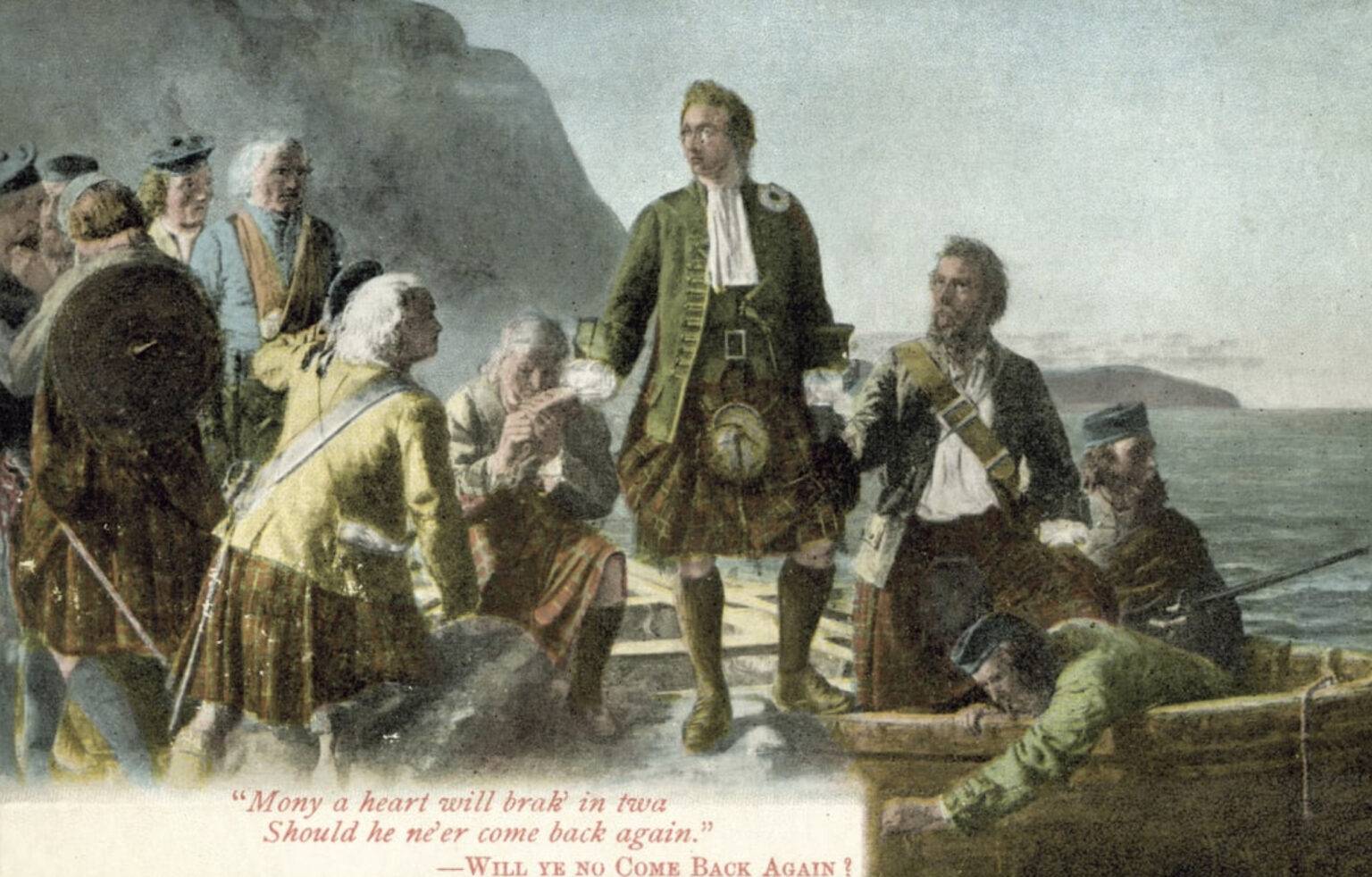
The 25 year-old Bonnie Prince Charlie addressing his troops, Jacobite Rising of 1745
Proscription and revival
The kilt is a traditional Scottish garment that has become a symbol of Scottish culture. However, the kilt has a complex history, and it was not always as popular as it is today.In the early 18th century, the British government imposed the Dress Act, which outlawed the wearing of kilts in an attempt to suppress Highland culture. The ban remained in effect for 35 years.During those years, the kilt became fashionable for Scottish romantics to wear as a form of protest against the ban. This was an age that romanticized “primitive” peoples, which is how Highlanders were viewed. Most Lowlanders had viewed Highlanders with fear before 1745, but many identified with them after their power was broken. The kilt, along with other features of Gaelic culture, had become identified with Jacobitism, and now that this had ceased to be a real danger it was viewed with romantic nostalgia.
Once the ban was lifted in 1782, Highland landowners set up Highland Societies with aims including “improvements” (which others would call the Highland clearances) and promoting “the general use of the ancient Highland dress”. The Celtic Society of Edinburgh, chaired by Walter Scott, encouraged lowlanders to join this antiquarian enthusiasm.
The kilt became identified with the whole of Scotland with the pageantry of the visit of King George IV to Scotland in 1822, even though 9 out of 10 Scots now lived in the Lowlands. Scott and the Highland societies organised a “gathering of the Gael” and established entirely new Scottish “invented traditions”, including Lowlanders wearing a stylised version of the traditional garment of the Highlanders. At this time many other traditions such as clan identification by tartan were developed (prior to this, tartans were identified with regions, not specific clans). After that point, the kilt gathered momentum as an emblem of Scottish culture as identified by antiquarians, romantics, and others, who spent much effort praising the “ancient” and natural qualities of the kilt. King George IV had appeared in a spectacular kilt, and his successor Queen Victoria dressed her boys in the kilt, widening its appeal. The kilt became part of the Scottish national identity and the wider Celtic identity.
ハイランドの氏族制度の特徴は、氏族員が神、君主、そして氏族長にのみ忠誠を誓っていたことである。ジャコバイト蜂起は、このようなハイランド人戦士氏族が中央政府にとって危険であることを示した。そのため、ジョージ2世王の政府は1746年に「服装令」を制定し、ハイランド人男性と少年がキルトを含むハイランド人衣装を着用することを違法にした。ただし、ハイランド連隊には例外が設けられた。この禁止令の目的は、ハイランド文化を抑制することであった。違反者には、初犯で6か月、再犯で7年の流刑という厳しい罰則が科された。この禁止令は35年間施行された。したがって、軍隊と軍隊に勤務する人々を除いて、キルトはスコットランド高地で使用されなくなった。しかし、この期間中、スコットランドのロマン主義者たちが禁止令に対する抗議としてキルトを着用することが流行した。これは、ハイランダーたちがどのように見られていたのかを示すように、「原始的な」民族をロマンチックに捉えていた時代であった。1745年以前は、ほとんどのローランド人はハイランダーたちを恐れていたが、彼らの力が奪われた後は、多くの人がハイランダーたちと同一視した。キルトは、ゲール文化の他の特徴とともに、ジャコバイトと同一視されるようになっていた。しかし、ジャコバイトがもはや現実的な危険ではなくなったため、キルトはロマンチックな懐旧の念を持って見られるようになった。
1782年に禁止令が解除されると、ハイランドの地主たちは「改良」(他の人々はハイランド・クリアランスと呼ぶ)と「古代ハイランド衣装の一般的な使用」を促進することを目的としたハイランド協会を設立した。ウォルター・スコットが会長を務めるエジンバラ・ケルト協会は、ローランド人たちにこの古物収集的な熱狂に参加するよう呼びかけた。1822年にジョージ4世がスコットランドを訪問した際、スコットランド全土の9割がローランド人居住地域になっていたにもかかわらず、キルトはスコットランド全体を象徴するものになった。スコットとハイランド協会は「ゲール人の集会」を組織し、ローランド人がハイランダーたちの伝統的な衣装を様式化して着用することなど、全く新しいスコットランドの「発明された伝統」を確立した。この時期には、氏族とタータンの識別など、他の多くの伝統も発達した(それ以前は、タータンは特定の氏族ではなく、地域と結びついていた)。その後、キルトは、キルトの「古代」で自然な品質を称賛するために多くの努力を費やした古物収集家、ロマン主義者、その他の人々によって、スコットランド文化の象徴として勢いを増していった。ジョージ4世は壮麗なキルトを身につけて登場し、彼の後継者であるヴィクトリア女王は自分の息子たちにキルトを着せ、キルトの魅力を広めた。キルトは、スコットランドの民族アイデンティティーとより広いケルトのアイデンティティーの一部となった。
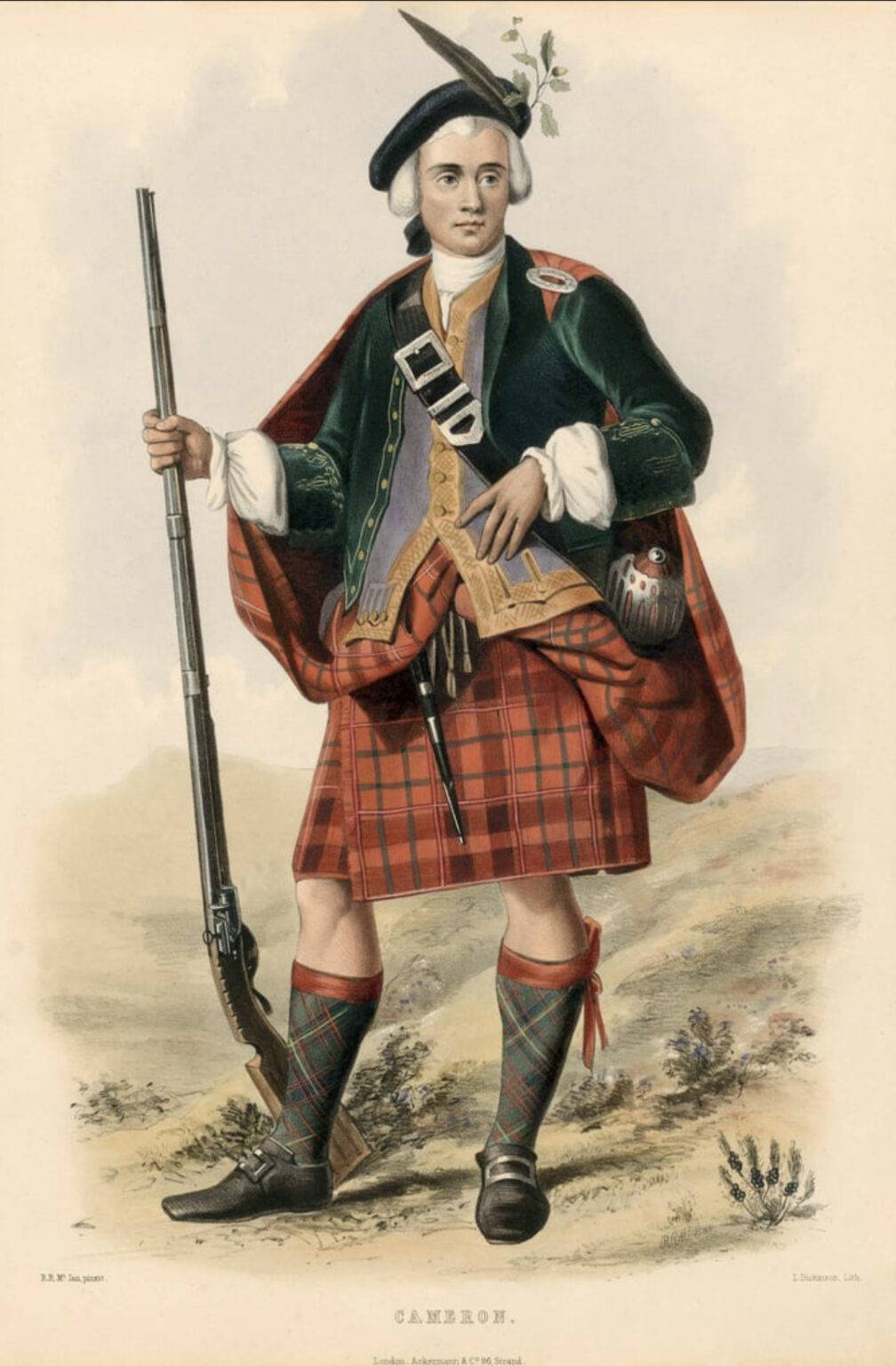



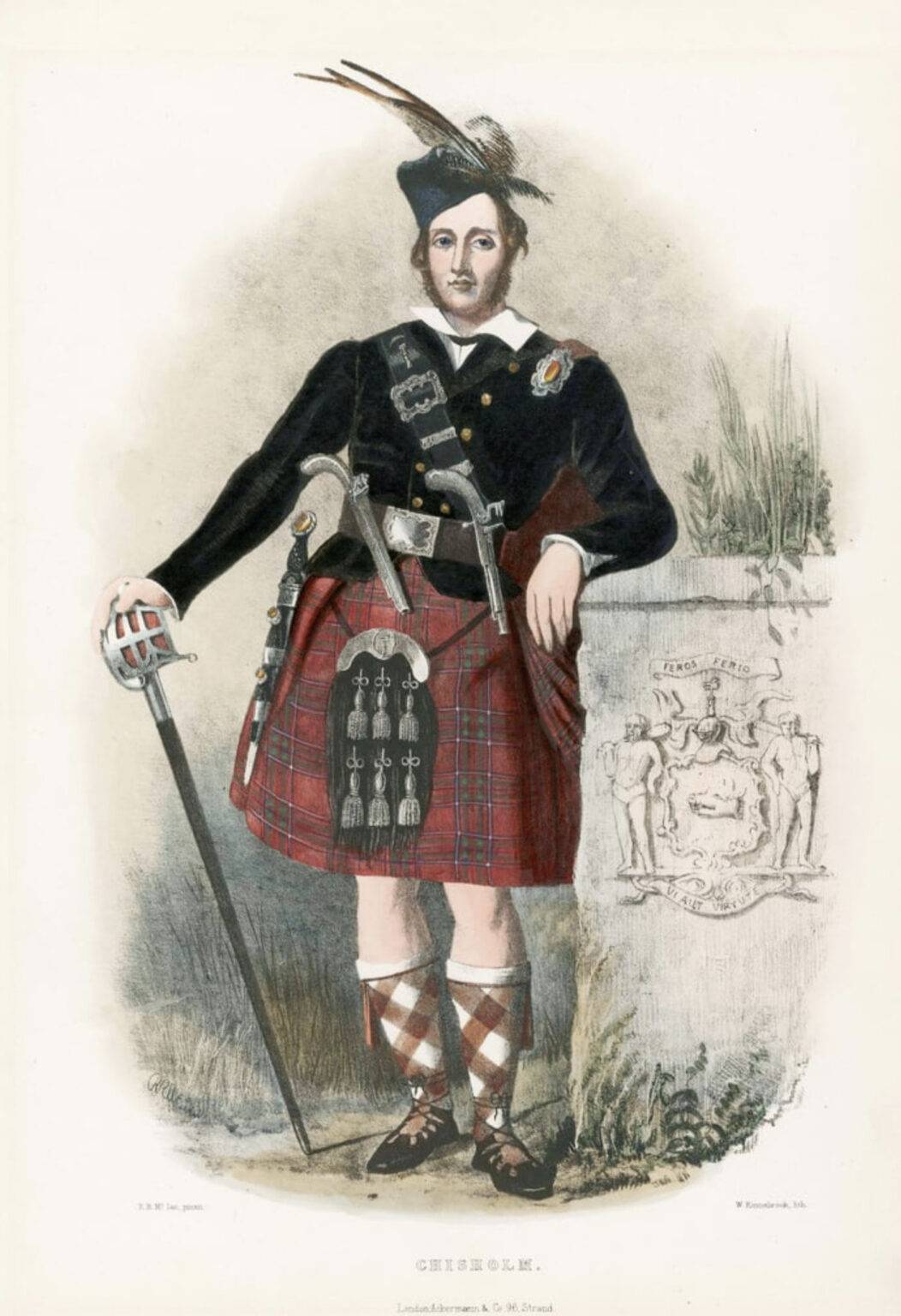
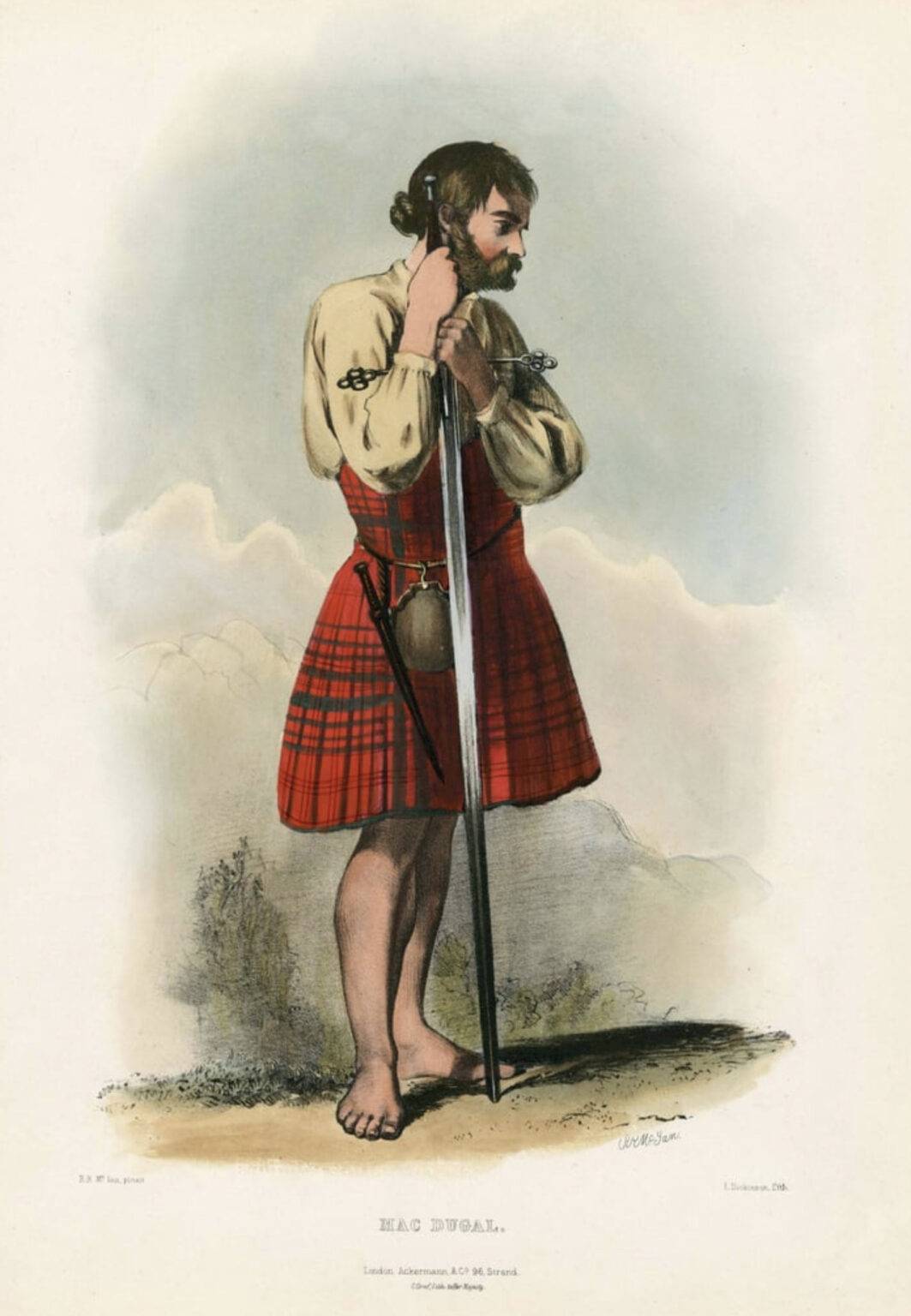
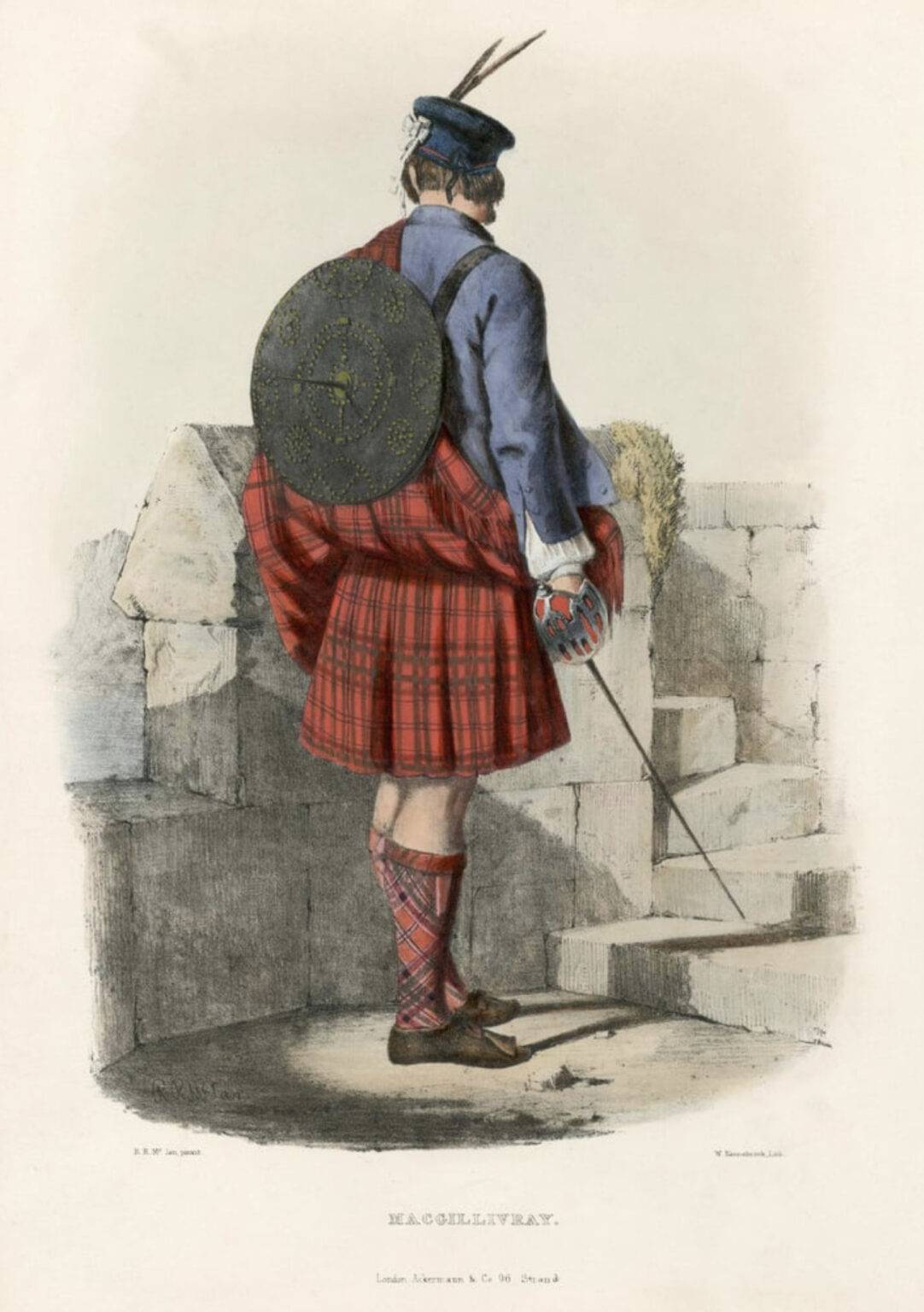
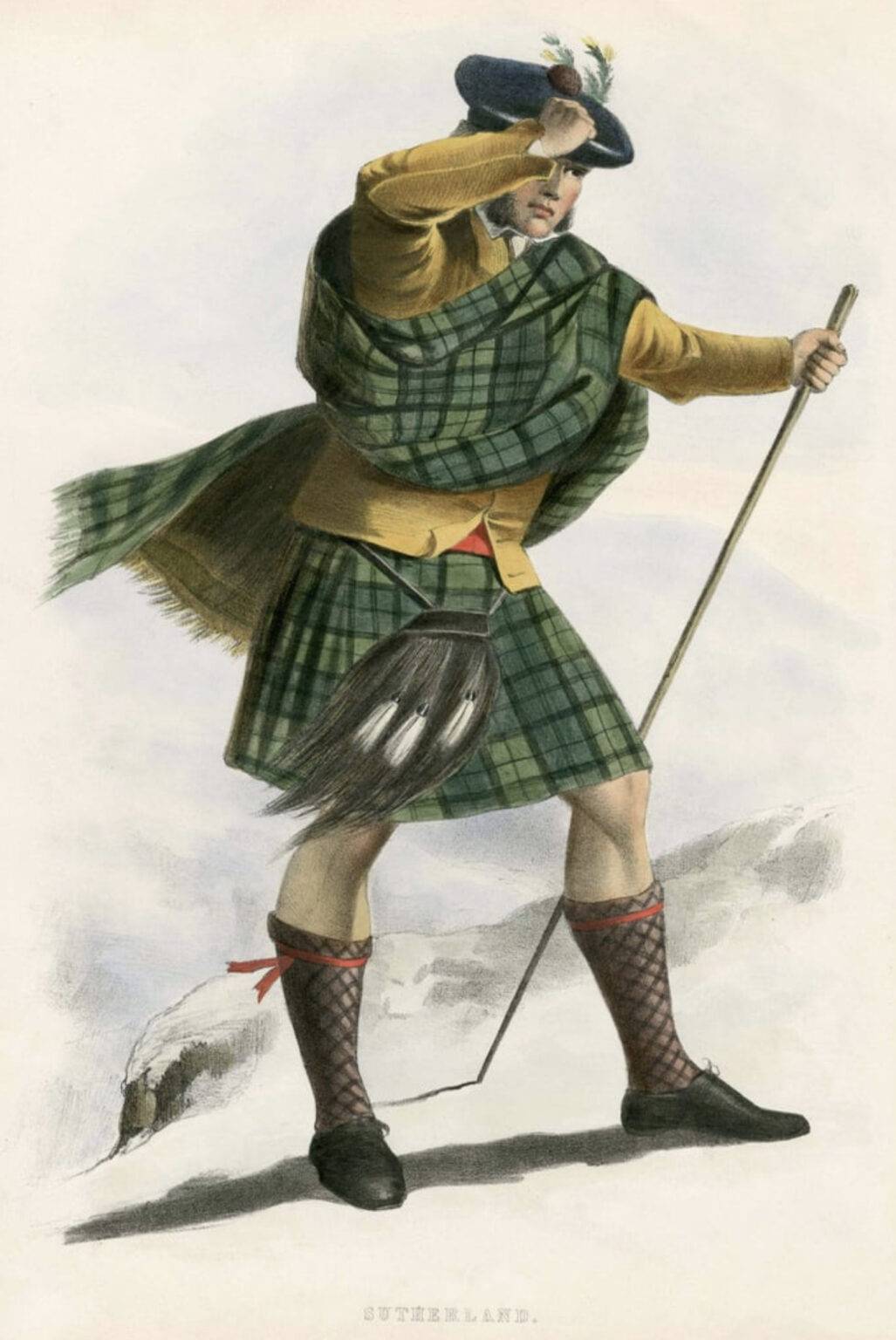
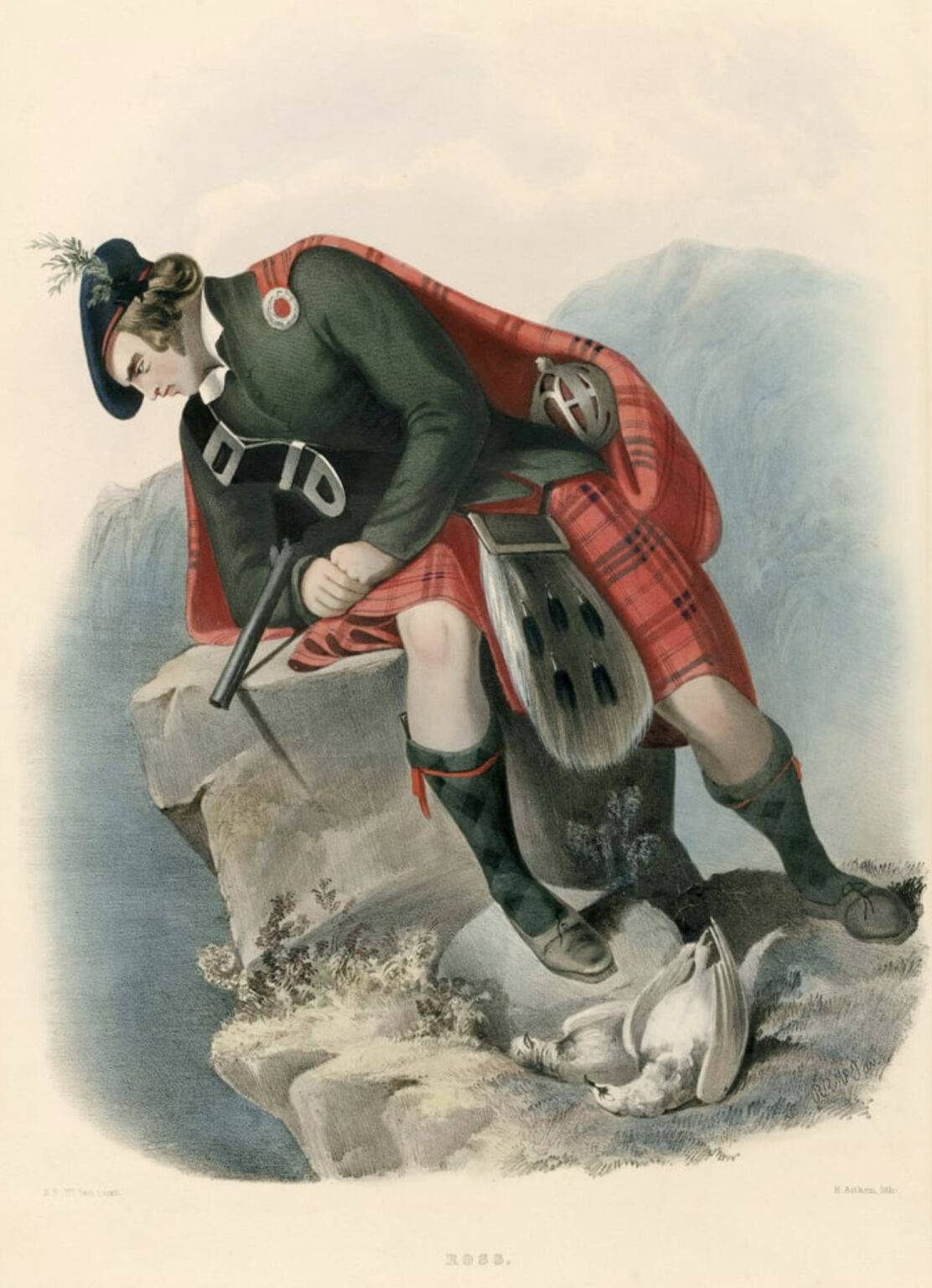
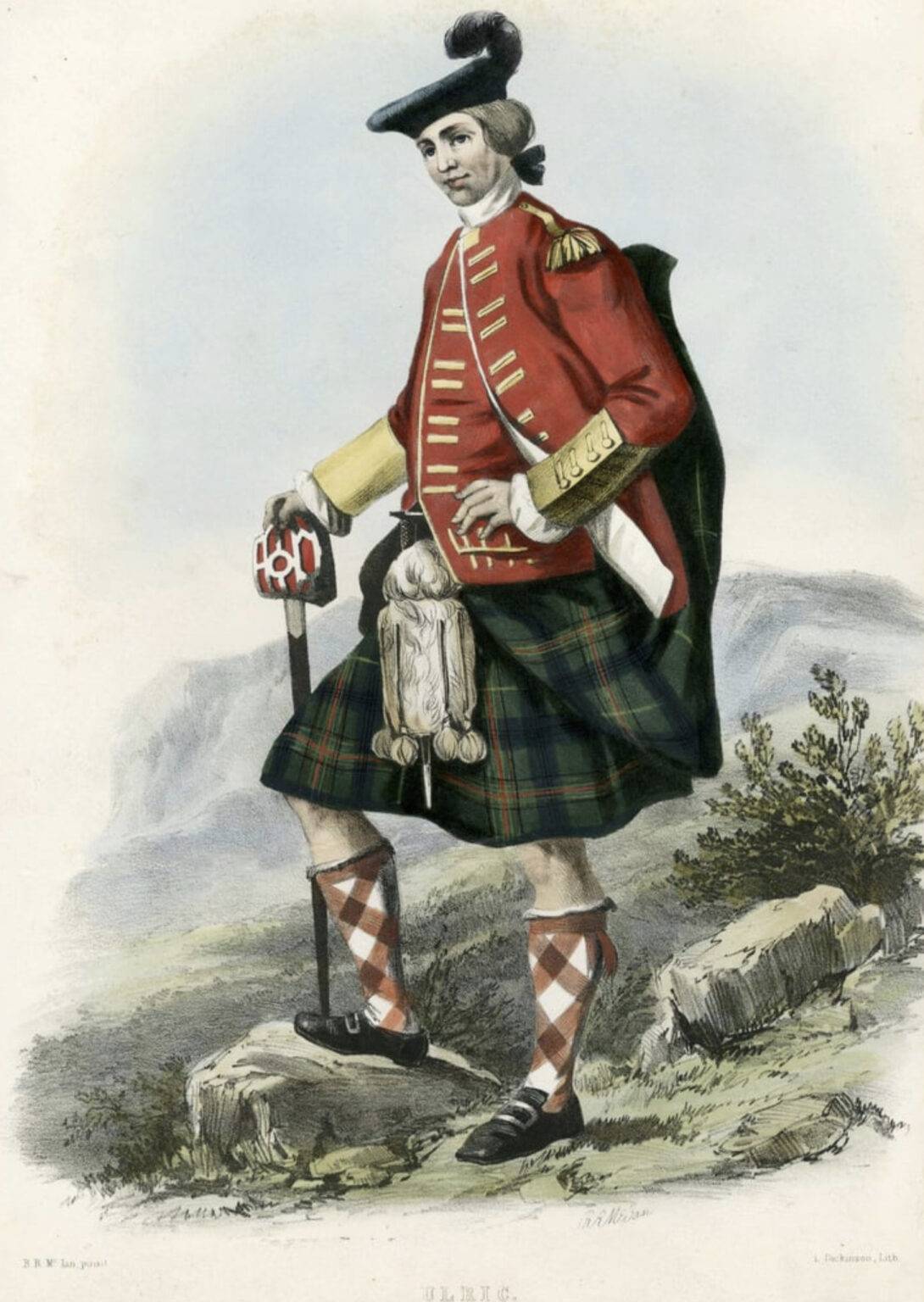



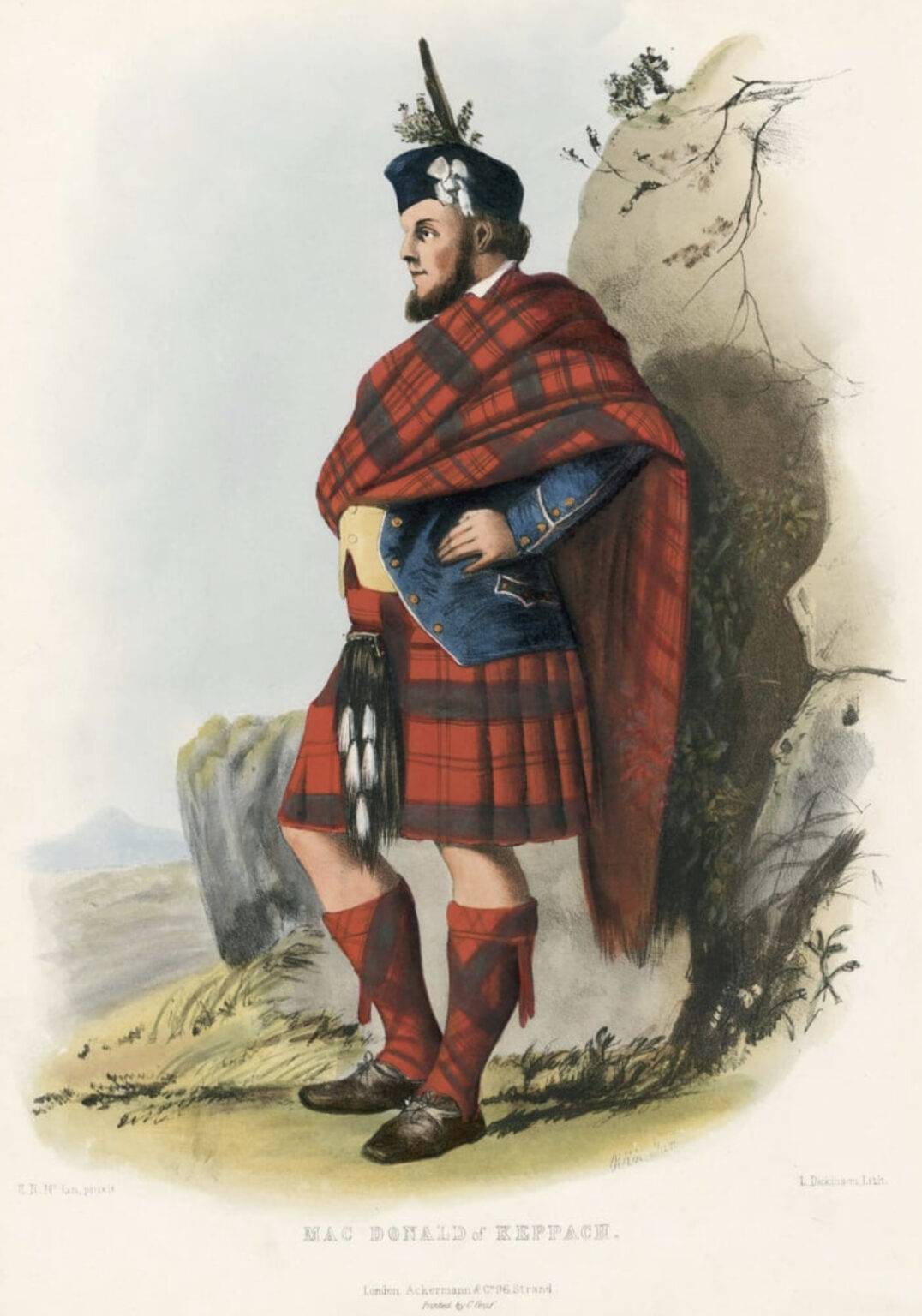
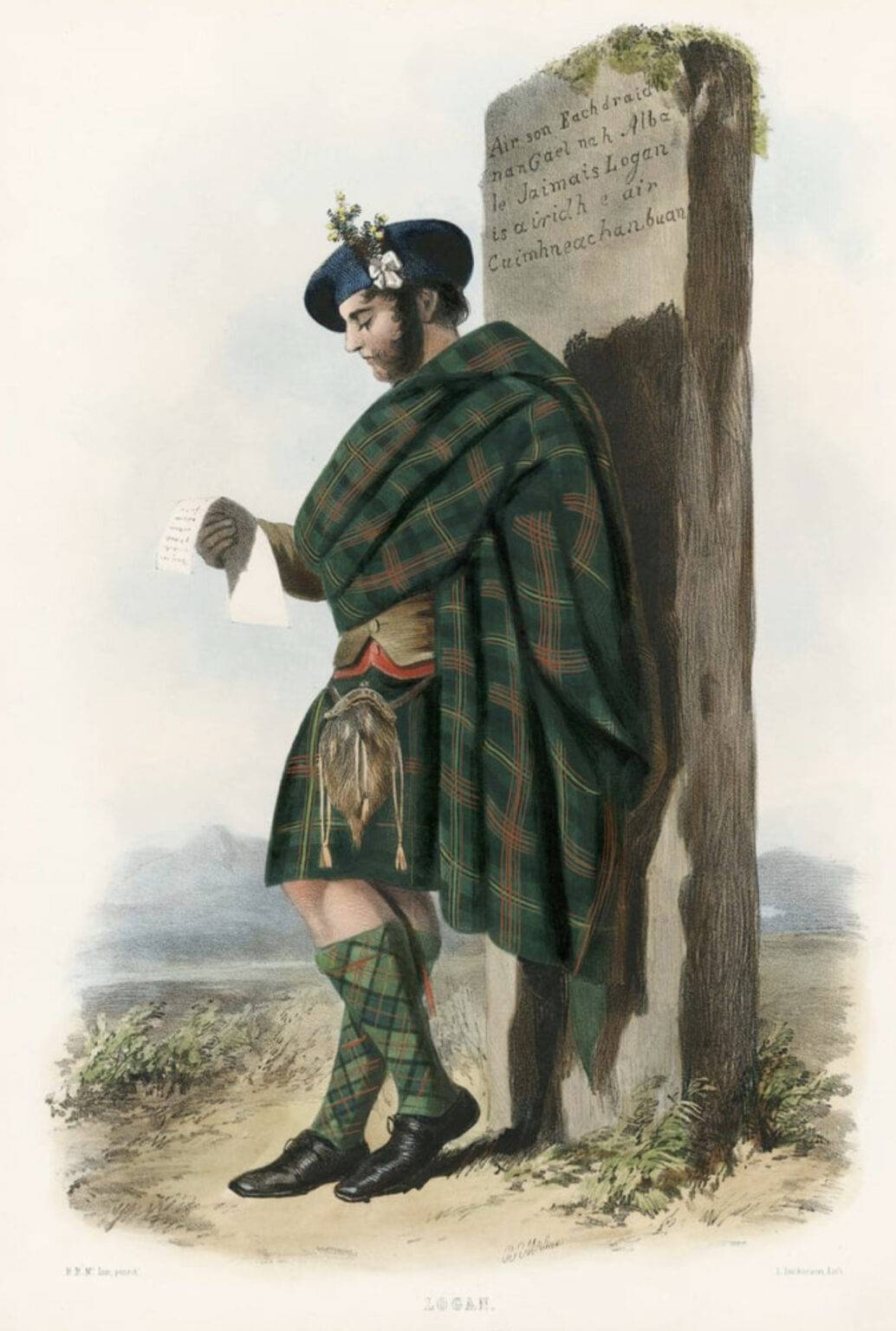
Robert Ronald McIan 1845
Scotish ARMY
Kilts were first worn by government troops in 1624 by the Independent Highland Companies. In 1739, these companies were amalgamated into the Earl of Crawford’s Highland Regiment, 43rd (later 42nd) Regiment of Foot, and their small-kilt uniform was standardized with a new dark tartan, today known as “Black Watch”, “Government 1”, “old Campbell”, and other names. Many Jacobite rebels adopted kilts as an informal uniform during the Jacobite rising of 1745, and even their English supporters wore tartan items. In the aftermath of the rebellion, the British government decided to form more Highland regiments for the army in order to redirect the energies of the Gaels, who were seen as a “hardy and intrepid race of men”. These regiments were given different tartans to identify them.Kilts were worn in combat by many Scottish units during the First World War. In particular, the ferocious tactics of the Black Watch led to their acquiring the nickname “Ladies from Hell” from the German troops that faced them in the trenches. Highland regiments of the Commonwealth armies entered the Second World War wearing the kilt, but it was rapidly recognized as impractical for modern warfare, and in the first year of the war was officially banned as combat dress. However, individual exceptions continued, and it is believed that the kilt was last widely worn in action at the evacuation of Dunkirk in May 1940. However, on D-Day, June 1944, Lord Lovat, commander of 1 Special Service Brigade, was accompanied by his personal piper Bill Millin, who wore a kilt and played the bagpipes while German bullets whizzed around him. Capt. Ogilvie of the Glider Pilot Regiment also landed in a kilt at Arnhem.The kerns of Gaelic Ireland wore the long léine, or ‘saffron shirt’ (often misinterpreted as a kilt in depictions), which may have had connections with the predecessor of the modern kilt. This tradition has been continued in the pipe bands of the Republic of Ireland’s defence forces.Today, kilts are utilized in the full-dress uniforms for multiple active Scottish regiments of the British Army who have some affiliation with Scotland. This includes the Royal Regiment of Scotland, Scots Guards, Royal Scots Dragoon Guards, and many other units.
This story has been repeated by many writers over the years, but it has also been disputed by others. There is no evidence to support the story in Rawlinson’s own papers, and some historians believe that it was invented to discredit the kilt as a national garb.However, it is clear that kilts were being worn in Scotland before the 1720s. There is evidence of Highlanders wearing only the bottom part of the belted plaid as early as the 1690s. And the earliest known portrait of a man wearing a small kilt dates to around 1747.So, while it is possible that Thomas Rawlinson played a role in popularizing the kilt, it is clear that he did not invent it.
1624年、インディペンデント・ハイランド・カンパニーは政府軍としてキルトを着用し、1739年にクロフォード伯爵ハイランド連隊(第43、後に第42歩兵連隊)に統合されると、彼らの小キルトの制服は新しい暗いタータン(今日では「ブラックウォッチ」「ガバメント1」「オールド・キャンベル」などと呼ばれる)で標準化されました。(彼らの大キルトのタータンは異なり、失われてしまいました。)多くのジャコバイト反乱軍がキルトを非公式な制服として採用し、1745年のジャコバイト蜂起の際には、イングランドの支持者さえもタータンのアイテムを着用しました。反乱の後、政府は「強健で勇敢な人種」であるゲール人のエネルギーを向けさせるために、陸軍にハイランド連隊を増設することを決定しました。このようにして、彼らは効果的な新しい陸軍連隊を編成し、インド、北アメリカ、その他の場所で戦わせながら、国内での反乱の可能性を低くしました。陸軍の制服は、ドレス法によるキルトの着用禁止から免除されており、連隊は区別をつけるために異なるタータンを与えられました。これらの連隊は、普段着の制服として現代的なキルトを選び、大キルトは正装の制服として残っていましたが、19世紀初頭には廃止されました。
多くのスコットランド軍部隊が第一次世界大戦中に戦闘でキルトを着用しました。特に、ブラックウォッチの猛烈な戦術により、彼らはトレンチで対峙したドイツ軍から「地獄の貴婦人」というニックネームを獲得しました。コモンウェルス軍のハイランド連隊は、第二次世界大戦にキルトを着用して参戦しましたが、近代戦には不向きであることがすぐに認識され、戦争開始1年目に戦闘服としては公式に禁止されました。それでも、個人の例外は続き、キルトが最後に広く着用されたのは1940年5月のダンケルク撤退戦であったと考えられています。しかし、1944年6月のD-Dayには、第1特別旅団の指揮官であるロバット卿が、ドイツ軍の銃弾が飛び交う中、キルトを着用してバグパイプを演奏する個人パイパーのビル・ミリンを伴っていました。また、グライダーパイロット連隊のオギルビー大尉は、アーネムでキルトを着用して上陸しました。ゲール・アイルランドのカーンズは、長いléine、または「サフラン色のシャツ」(絵画ではしばしばキルトと誤解される)を着用していました。これは、現代のキルトの前身とつながりがあったかもしれません。この伝統は、アイルランド国防軍のパイプバンドに引き継がれています。キルトは、スコットランドと何らかの関係を持つ英国陸軍の複数の現役スコットランド連隊の現代の正装制服に使用されています。これには、ロイヤル・レジメント・オブ・スコットランド、スコッツガーズ、ロイヤル・スコッツ・ドラグーンガードなどの連隊が含まれます。
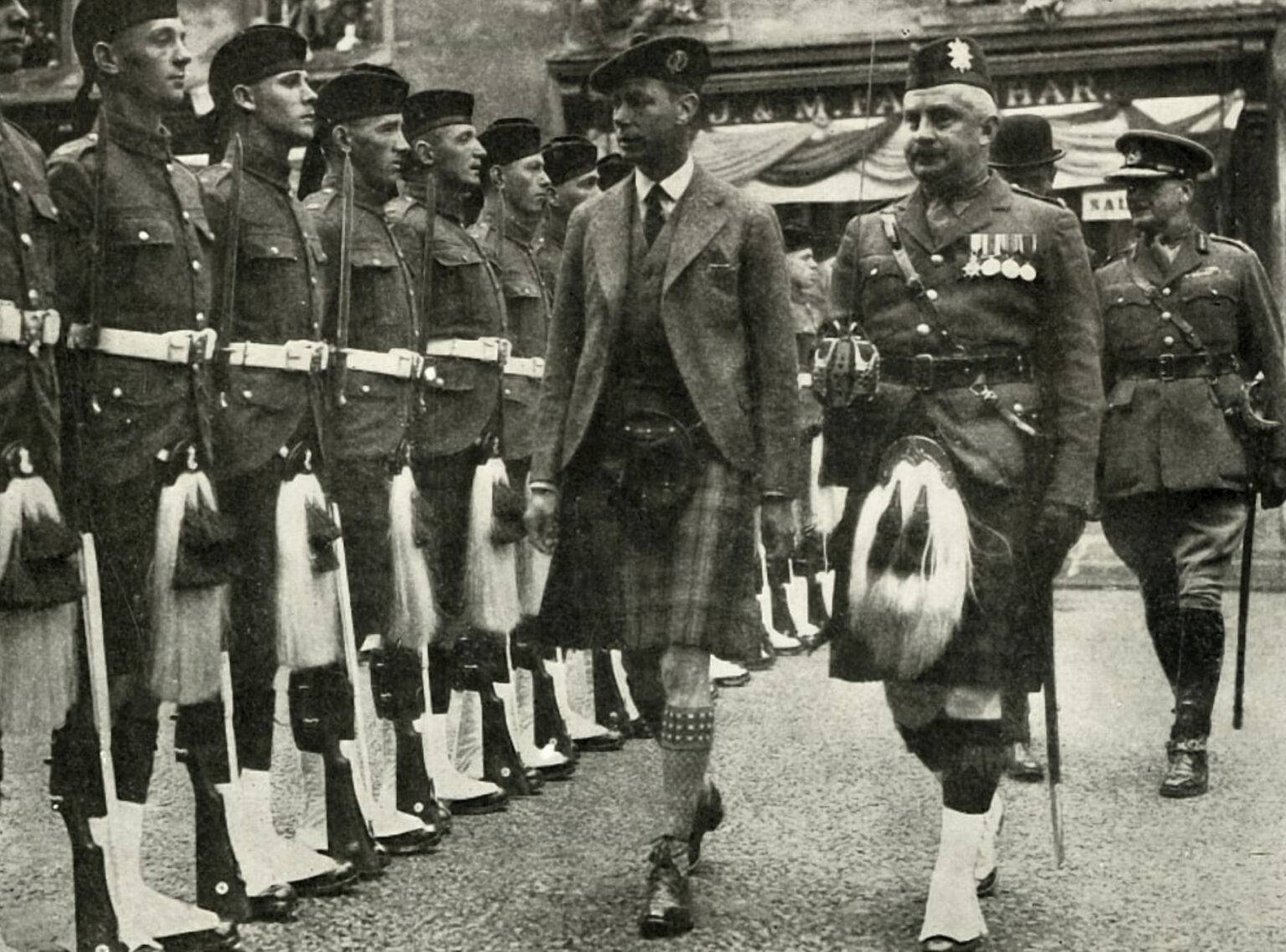
His Majesty Inspecting The Guard Of Honour Of The Black Watch At Perth in August, 1935.
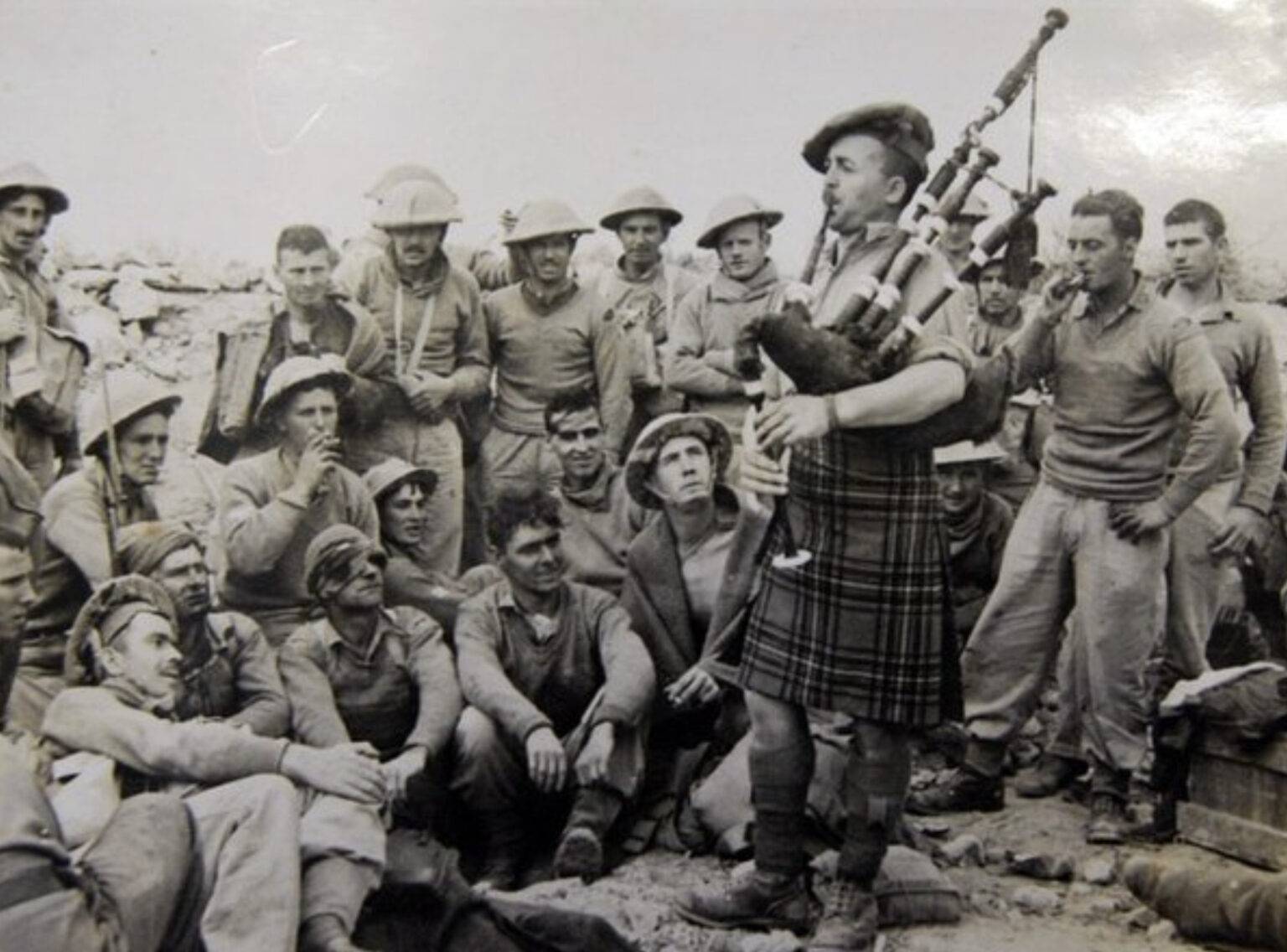
Pipe Major “Rab’ Roy, 2nd Bn. The Black Watch, Tobruk 1941
– recommendation –
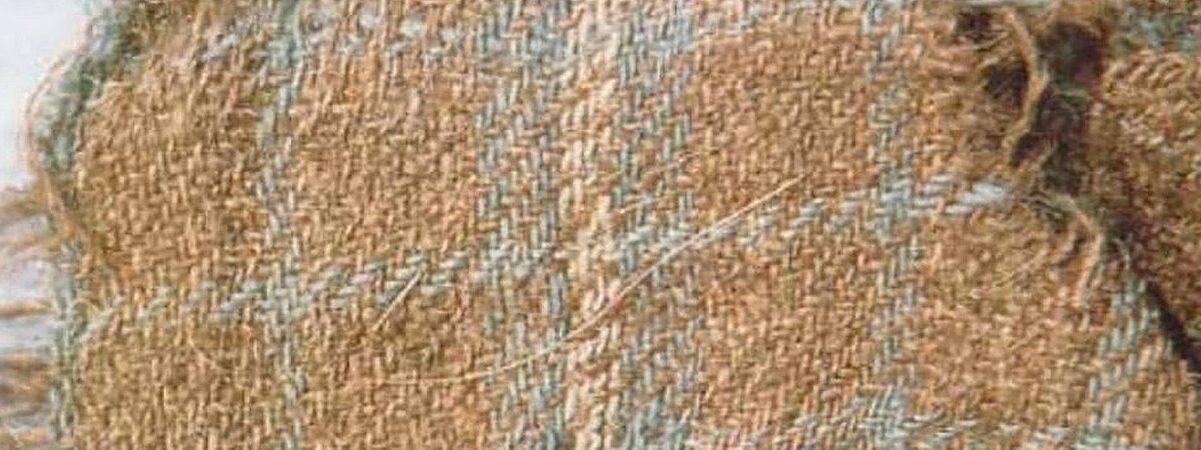
THE WORLD OLDEST TARTAN
The earliest surviving sample of tartan fabric was found in a cemetery in the Tarim Basin, China. It dates back to around 1200 B.C. and is made of kemp, the coarse outer hair of a sheep or goat. The fabric is similar to Scottish tartan of the 17th century, suggesting that these two cultures may have had a common ancestor.It means that the tartan also crossed over to the east. Let’s look at a piece of history.
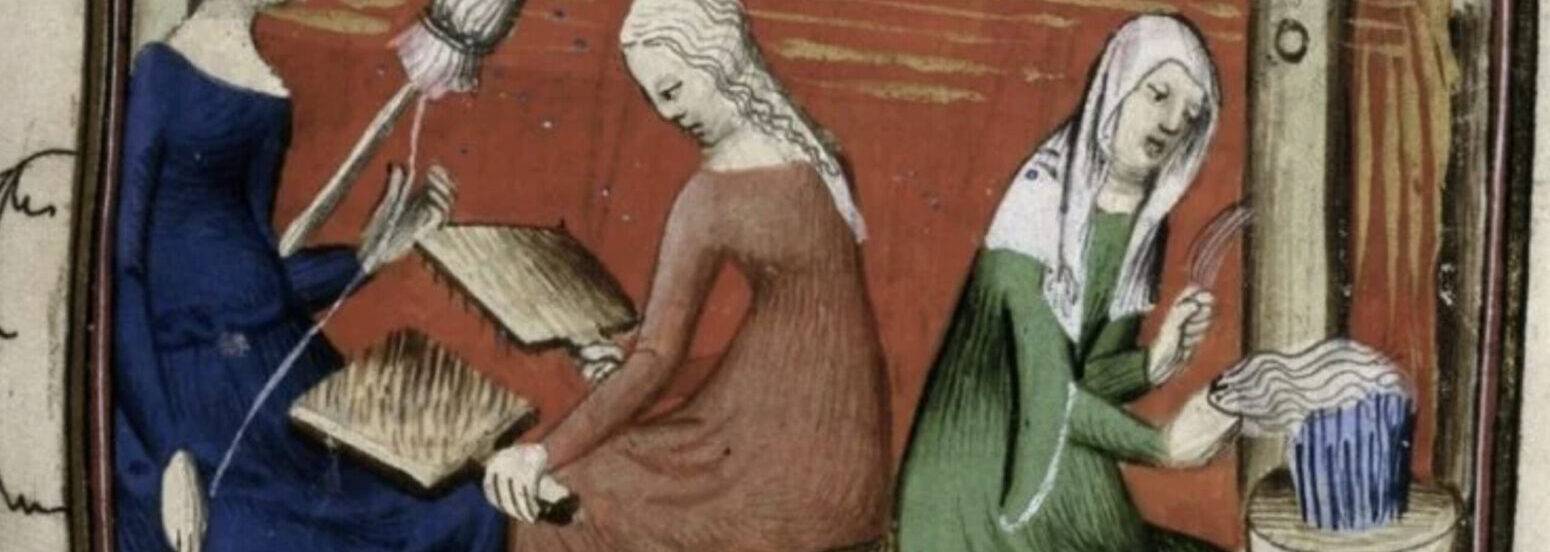
COMBED AND SPUN WOOL / WORSTED AND WOOLEN
Understanding the difference between “combed(worsted)” and “spun(woolen)” is one of the most difficult things for a layman to grasp when they first start learning about yarn. It took me a long time to understand the difference myself, perhaps because I didn’t have any yarn to experiment with. Without any yarn to see and touch, it can be difficult to understand how it is made. The same is true for other materials, but wool is particularly challenging to understand. However, it is surprising how little-known it is that wool has been a necessity in human life since before Christ. Let’s study the very first part of this story together.
MISSING “VIYELLA FLANNEL”
The fabric we currently call “Viyella” is not real “Viyella”. “Viyella” is a blend of wool and cotton first woven in 1893 in England,and soon to be the “first branded fabric in the world”. It was made of 55 % Lambs wool and 45 % Egyptian cotton in a twill weave,developed by James and Robert Sissons of William Hollins & Co, spinners and hosiers.


